Hotpoint-Ariston AQLF8F 292 U: инструкция
Раздел: Бытовая, кухонная техника, электроника и оборудование
Тип: Стиральная Машина
Инструкция к Стиральной Машине Hotpoint-Ariston AQLF8F 292 U

EN
1
English,1
Contents
Installation, 2-3
Unpacking and levelling
Connecting the electricity and water supplies
Technical data
Description of the machine, 4-5
Control panel
Auto Dose System, 6-7
Running a wash cycle, 8
Wash cycles and options, 9
Table of wash cycles
Wash options
Detergents and laundry, 10
Detergent
Preparing the laundry
Washing recommendations
Load balancing system
Precautions and advice, 11
General safety
Disposal
Opening the porthole door manually
Care and maintenance, 12
Cutting off the water and electricity supplies
Cleaning the machine
Cleaning the detergent dispenser drawer
Caring for your appliance drum
Cleaning the pump
Checking the water inlet hose
Trouble shooting, 13-14
Assistance, 15
EN
WASHING MACHINE
AQUALTIS
AQLF8F 292 U
Instructions for
installation and use
Italiano,17
I
TR
Türkçe,49
CIS
Ðóññêèé,33
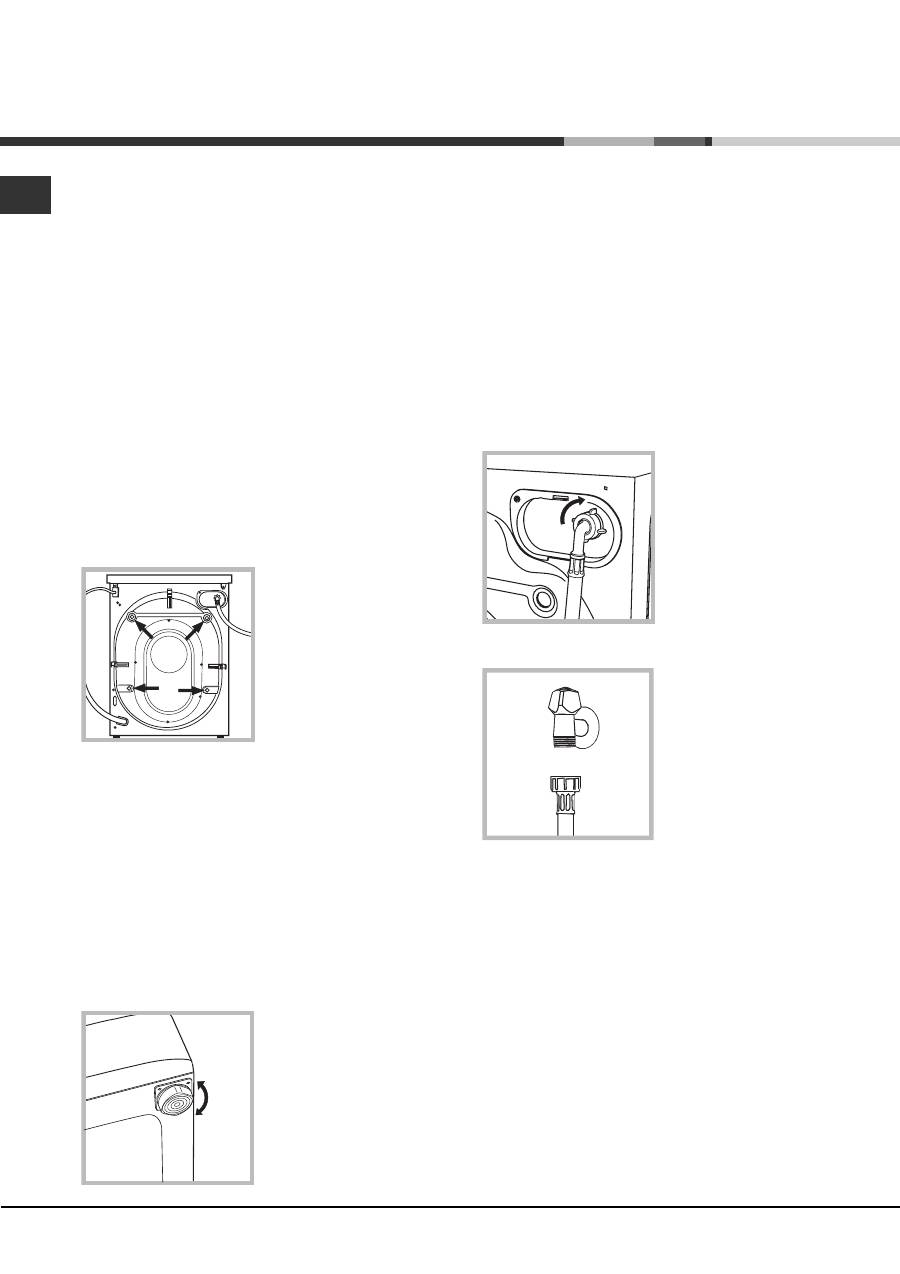
EN
2
Installation
This instruction manual should be kept in a safe place
for future reference. If the washing machine is sold,
given away or moved, please ensure the manual is kept
with the machine, so that the new owner may benefit
from the advice contained within it.
Read these instructions carefully: they contain vital
information relating to the safe installation and operation
of the appliance.
Inside the pack containing this manual, you will also
find the guarantee and all the details necessary for
installation.
Unpacking and levelling
Unpacking
1. Once you have removed all the packaging from the
washing machine, make sure it has not been damaged
during transportation.
If it has been damaged, contact the retailer and do not
proceed any further with the installation process.
2. Remove the 4
protective screws (used
during transportation) and
the corresponding spacer,
located on the rear part of
the appliance (
see figure
).
3. Close off the holes using the plastic plugs supplied in
the pack.
4. Keep all the parts in a safe place;
they will be
needed again if the washing machine is moved to
another location, to prevent the inside of the
appliance being damaged.
Packaging materials should not be used as toys for
children.
Levelling
1. Place the washing machine on a flat sturdy floor,
without resting it up against walls or cabinets.
2. If the floor is uneven,
the front feet of the
machine may be adjusted
until it reaches a horizontal
position (the angle of
inclination must not
exceed 2 degrees).
If the appliance is levelled correctly, it will be more
stable and much less likely to cause vibrations and noise
while it is operating, particularly during the spin cycle.
If it is placed on carpet or a rug, adjust the feet in such
a way as to allow a sufficient ventilation space
underneath the washing machine.
Connecting the electricity and water
supplies
Connecting the water inlet hose
Before connecting the inlet hose to the water supply,
run the water until it is perfectly clear.
1. Connect the inlet hose
to the machine by
screwing it onto the cold
water inlet of the
appliance, which is
situated on the top right-
hand side of the rear part
of the appliance
(see
figure)
.
2. Connect the inlet hose
by screwing it to a cold
water tab using a 3/4 gas
threaded connection
(see
figure)
.
3. Make sure that the hose is not folded over or bent.
The water pressure at the tap must fall within the
values indicated in the Technical data table
(see next
page).
If the inlet hose is not long enough, contact a
specialised shop or an authorised technician.
Never use second-hand or old inlet hoses; use the
products supplied with the machine.
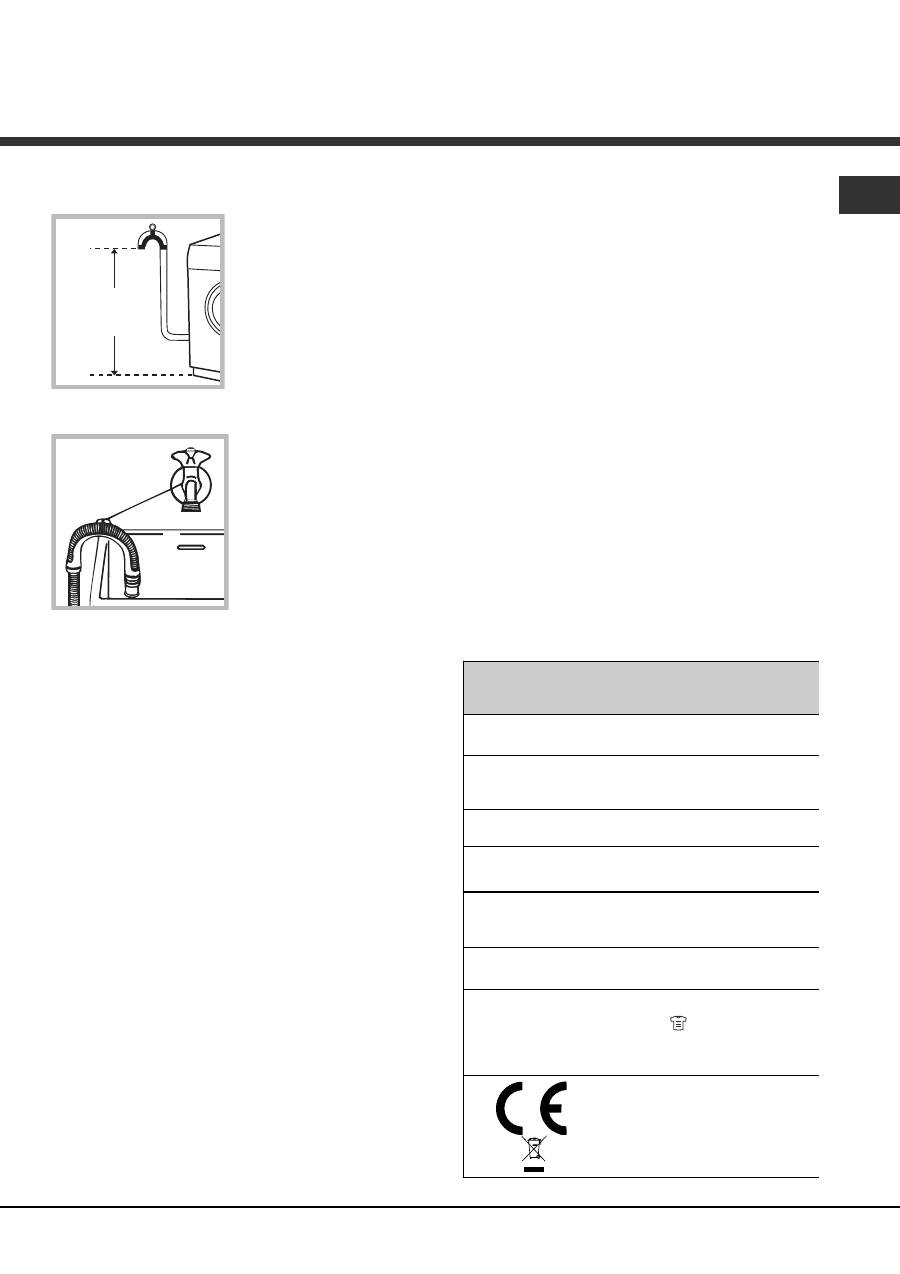
EN
3
Technical data
Model
AQLF8F 292 U
Dimensions
width 59.5 cm
height 85 cm
depth 64,5 cm
Capacity
from 1 to 8 kg
Electrical
connections
please refer to the technical data
plate fixed to the machine
Water connections
maximum pressure 1 MPa (10 bar)
minimum pressure 0.05 MPa (0.5 bar)
drum capacity 62 litres
Spin speed
up to 1200 rotations per minute
Energy rated
programmes
according to
regulation
2010/1061
programme ; temperature 60°C
and 40°C.
This appliance conforms to the
following EC Directives:
- 2004/108/EC (Electromagnetic
Compatibility)
- 2006/95/EC (Low Voltage)
- 2002/96/EC
65 - 100 cm
Connecting the drain hose
Connect the drain hose to
drain duct piping or a wall
drain located between 65
and 100 cm above the
floor, making sure it is not
bent at all.
Alternatively, rest the drain
hose on the side of a
washbasin or bathtub,
fastening the duct
supplied to the tap
(see
figure).
The free end of the hose
should not be underwater.
We advise against the use of hose extensions; if it is
absolutely necessary, the extension must have the same
diameter as the original hose and must not exceed 150
cm in length.
Electrical connections
Before plugging the appliance into the electricity socket,
make sure that:
the socket is earthed and complies with all applicable
laws;
the socket is able to withstand the maximum power
load of the appliance as indicated in the Technical
data table
(see opposite);
the supply voltage is included within the values
indicated on the Technical Data Plate fixed on the
machine;
the socket is compatible with the plug of the
appliance. If this is not the case, have the socket or
the plug replaced.
The machine must not be installed outdoors, even in
covered areas. It is extremely dangerous to leave the
appliance exposed to rain, storms and other weather
conditions.
The mains socket must remain within easy reach after
the washing machine has been installed.
Do not use extension cords or multiple sockets.
The cable should not be bent or compressed.
The power supply cable and plug must only be
replaced by authorised technicians.
Warning! The company shall not be held responsible in
the event that these regulations are not respected.
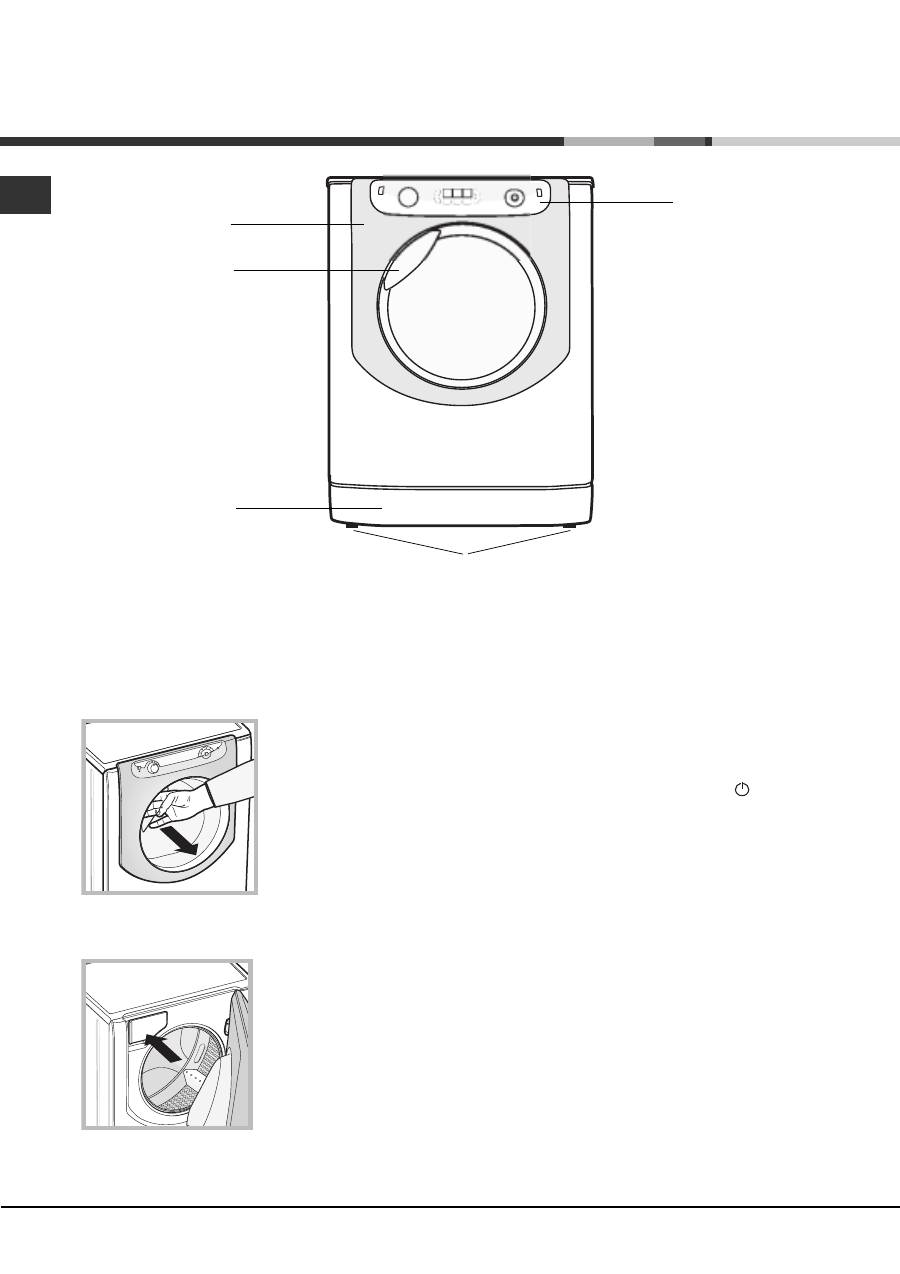
EN
4
CONTROL
PANEL
PORTHOLE DOOR
PORTHOLE DOOR
HANDLE
KICK STRIP
ADJUSTABLE FEET
Description of the machine
PORTHOLE DOOR
Always use the handle to
open the porthole door
(see
figure).
DETERGENT DISPENSER DRAWER
The detergent dispenser
drawer is located inside the
machine and can be
accessed by opening the
door.
Refer to the chapter "
Auto
Dose System
" for information
on operation.
Note:
stick the label showing
the wash cycle descriptions
and options on the front of
the detergent dispenser drawer. You will find the sticker
in the pack containing this manual.
Standby mode
This washing machine, in compliance with new energy
saving regulations, is fitted with an automatic standby
system which is enabled after about 30 minutes if no
activity is detected. Press the ON-OFF button briefly
and wait for the machine to start up again.
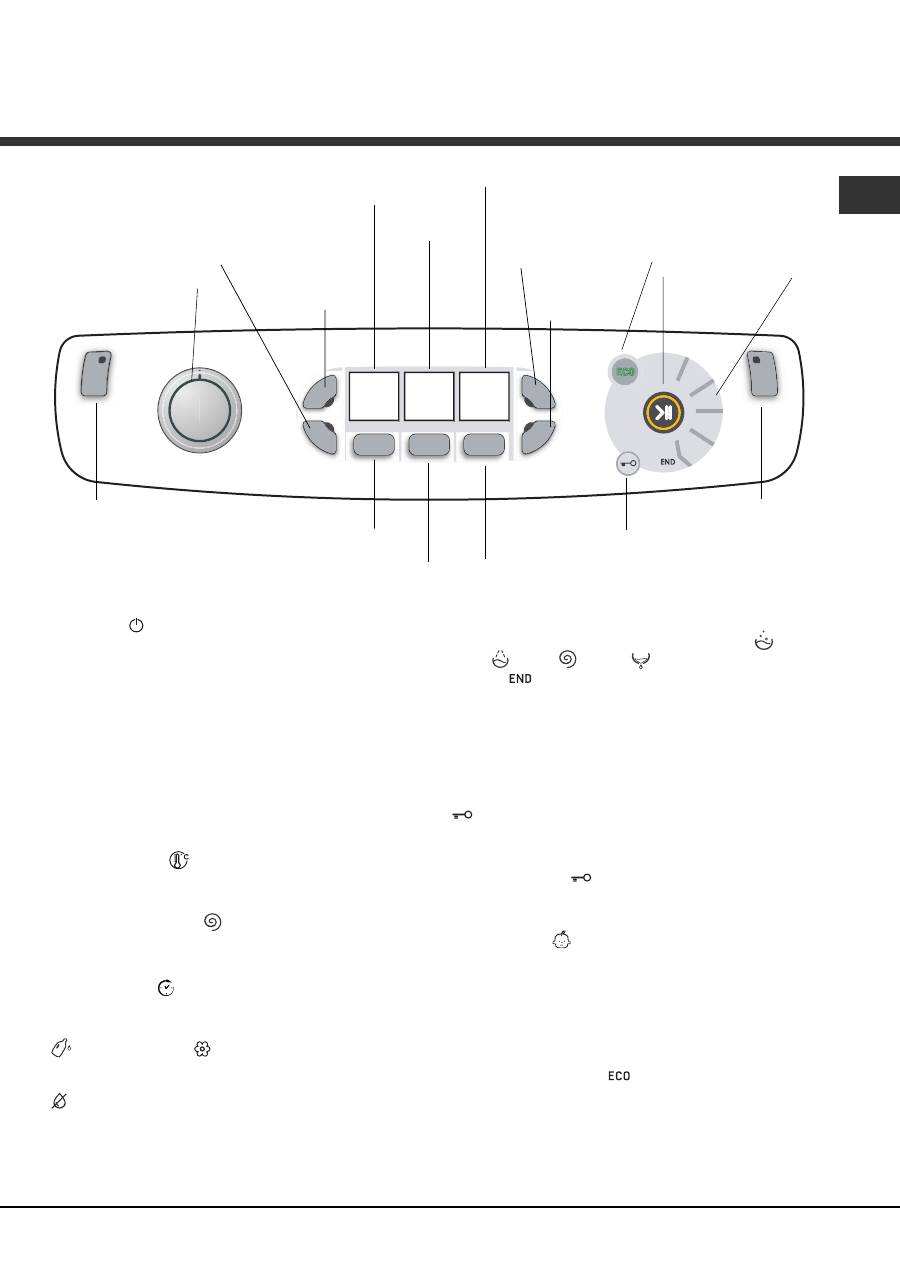
EN
5
TEMPERATURE
button
WASH CYCLE
SELECTOR
knob
DOOR LOCKED
indicator light
START/PAUSE
button with indicator
light
WASH
CYCLE
PHASE
icons
DELAY
TIMER
button
CHILD LOCK
button
with indicator light
ON/OFF
button with
indicator light
ECO
indicator light
TEMPERATURE/
DETERGENT
display
SPIN
display
DELAY TIMER/SOFTENER /
CYCLE DURATION
display
Control panel
Button with
ON/OFF
indicator light: press this briefly
to switch the machine on or off. The green indicator light
indicates that the machine is switched on. To switch off
the washing machine during the wash cycle, press and
hold the button for approximately 3 seconds; if the
button is pressed briefly or accidentally the machine will
not switch off. If the machine is switched off during a
wash cycle, this wash cycle will be cancelled.
WASH CYCLE SELECTOR
knob: may be turned in
either direction. To select the most suitable wash cycle,
please refer to the
Table of wash cycles.
The knob will not move during the wash cycle.
TEMPERATURE
button: press to modify or exclude
the temperature setting; the value selected will appear
on the display above
(see Running a wash cycle).
SPIN SPEED CYCLE
button: press to modify or
exclude the spin cycle; the value selected will appear on
the display above
(see Running a wash cycle).
DELAY TIMER
button: press to set a DELAY TIMER
for the selected wash cycle; the set delay time will appear
on the display above
(see Running a wash cycle).
DETERGENT
and
SOFTENER
buttons
:
refer to
"Modifying pre-set parameters"
in the chapter "
Auto Dose
System
".
DETERGENT DILUTION
button
:
refer to "
Filling the
tanks
" in the chapter "
Auto Dose System
".
OPTION
button with indicator light: press to select the
available options. The indicator light corresponding to the
selected option will remain lit
(see Running a wash cycle).
WASH CYCLE PHASE
icons
:
these illuminate to
indicate the progress of the wash cycle (Wash
Rinse Spin Drain
).
The text
lights up when the cycle is complete.
START/PAUSE
button with indicator light: when the
green indicator light flashes slowly, press the button to
start a wash cycle. Once the cycle has begun the
indicator light will remain lit in a fixed manner. To pause
the wash cycle, press the button again; the indicator
light will flash in an orange colour. If the Door locked
indicator light is switched off, the door may be
opened. To start the wash cycle from the point at which
it was interrupted, press the button again.
DOOR LOCKED
indicator light: indicates that the
porthole door is locked. To open the door, pause the
wash cycle (see
Running a wash cycle
).
CHILD LOCK
button with indicator light: to activate
or deactivate the CHILD LOCK, press and hold the
button for approximately 2 seconds. when the indicator
light is illuminated, the control panel is locked. This
means it is possible to prevent wash cycles from being
modified accidentally, especially where there are children
in the home.
ECO
indicator light: the
icon lights up when, after
altering the washing parameters, an energy saving of at
least 10% is made. Furthermore, before the machine
enters Standby mode, the icon will light up for a few
seconds; when the machine is switched off the
estimated energy saving will be around the 80% mark.
SPIN SPEED
button
OPTION
button
with indicator light
DETERGENT
DILUTION
button
DETERGENT
button
SOFTENER
button
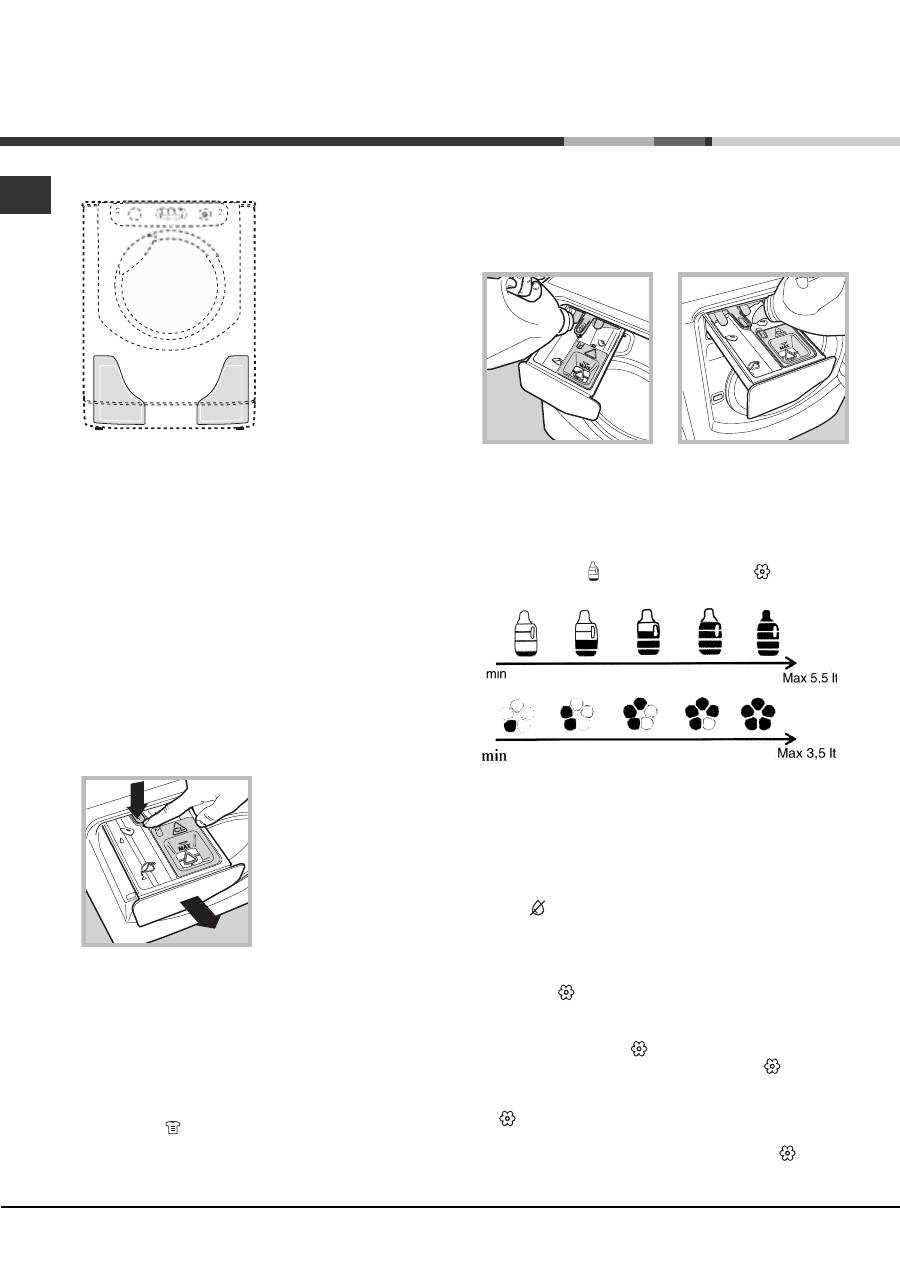
EN
6
Introduction
This washing machine is
equipped with two tanks: one
for liquid detergent (either
concentrated or diluted) with
a capacity of approx. 5.5 l
and another for liquid fabric
softener (either concentrated
or diluted) with a capacity of
approx. 3.5 l
(see picture)
.
Check the detergent/fabric
softener box to verify whether
it is diluted or concentrated
detergent.
The automatic
dosing system intakes the
correct amount of detergent and fabric softener from the
tanks for each type of load and at the right time,
guaranteeing optimal washing results without wastage.
The amount of detergent/fabric softener can be modified
manually by pressing the DETERGENT and FABRIC
SOFTENER buttons (refer to "
Modifying pre-set
parameters
"). If you prefer, the washing machine can
also be used in the "traditional" mode, i.e. by adding the
detergent in the dispenser; the machine will automatically
detect the detergent and will not use the tanks.
Detergent dispenser
"Traditional" mode.
Pull out the detergent dispenser drawer up to the first
stop point to add the detergent (either liquid or powder
detergent), bleach or other additives (e.g. whiteners) and
the pre-wash detergent for washing in the "
traditional
"
mode (refer to "
Traditional
mode).
"Auto Dose System
mode.
In order to fill the
detergent
and fabric softener tanks,
the detergent dispenser
drawer must be fully
extracted
: open the dispenser
drawer up to the first stop
point then press the lever (
A
)
and open up to the second
stop point,
making sure that
it is fully extracted. Avoid
moving the dispenser drawer during filling operations
.
Once the tanks have been filled
(refer to "Filling the tanks")
,
the machine can run up to 40 cycles before the detergent
finishes
(*).
First-time use
Turn the washing machine on by pressing the ON/OFF
button. The first wash cycle must be carried out without
laundry and by adding detergent in the detergent
dispenser (refer to "
Traditional
mode); set the
programme " " (Cotton 90°) without pre-wash and
without filling the tanks.
Filling the tanks:
Open the detergent dispenser drawer in the "
Auto Dose
System
" mode (refer to "
Detergent dispenser
").
Slowly pour the detergent (
B
) and fabric softener (
C
)
until the tanks are completely filled (
see picture
).
To avoid exceeding the maximum capacity, a buzzer
(beep) will sound with growing intensity to signal the level
and 3 long beeps will sound once the tank is completely
full.
Start the wash cycle immediately after filling the tanks to
ensure that the dispenser is properly cleaned.The
respective icons (for the detergent) and (for the
fabric softener) will light up gradually to signal the level.
The filling time depends on the density of the product.
Very dense products will take longer to fill.
Close the detergent dispenser drawer only once the
compartments are completely empty.
Select the density of the detergent added (either
concentrated or liquid) by pressing the appropriate
button .
The machine will store the selection.
If no option is selected, the detergent intake option will
be pre-set to "
diluted
".
Use button to set the amount of fabric softener that
will be automatically extracted by the machine:
1)
If concentrated softener is used, we recommend
selecting the first level ( with one bar) and, if
necessary, stepping up by a single position ( with 2
bars) to increase detergent intake.
2)
If diluted softener is used, we recommend setting level
3 ( with 3 bars) and to then either increase/decrease
the amount of fabric softener to be extracted.
3)
To exclude the use of fabric softener, press until
the bars disappear (also refer to "
Modifying pre-set
parameters
").
A
B
C
Auto Dose System
(*)
with an average load of 4 kg, 40°C Cotton programme, "medium" water
hardness level and dirt level set to 3.
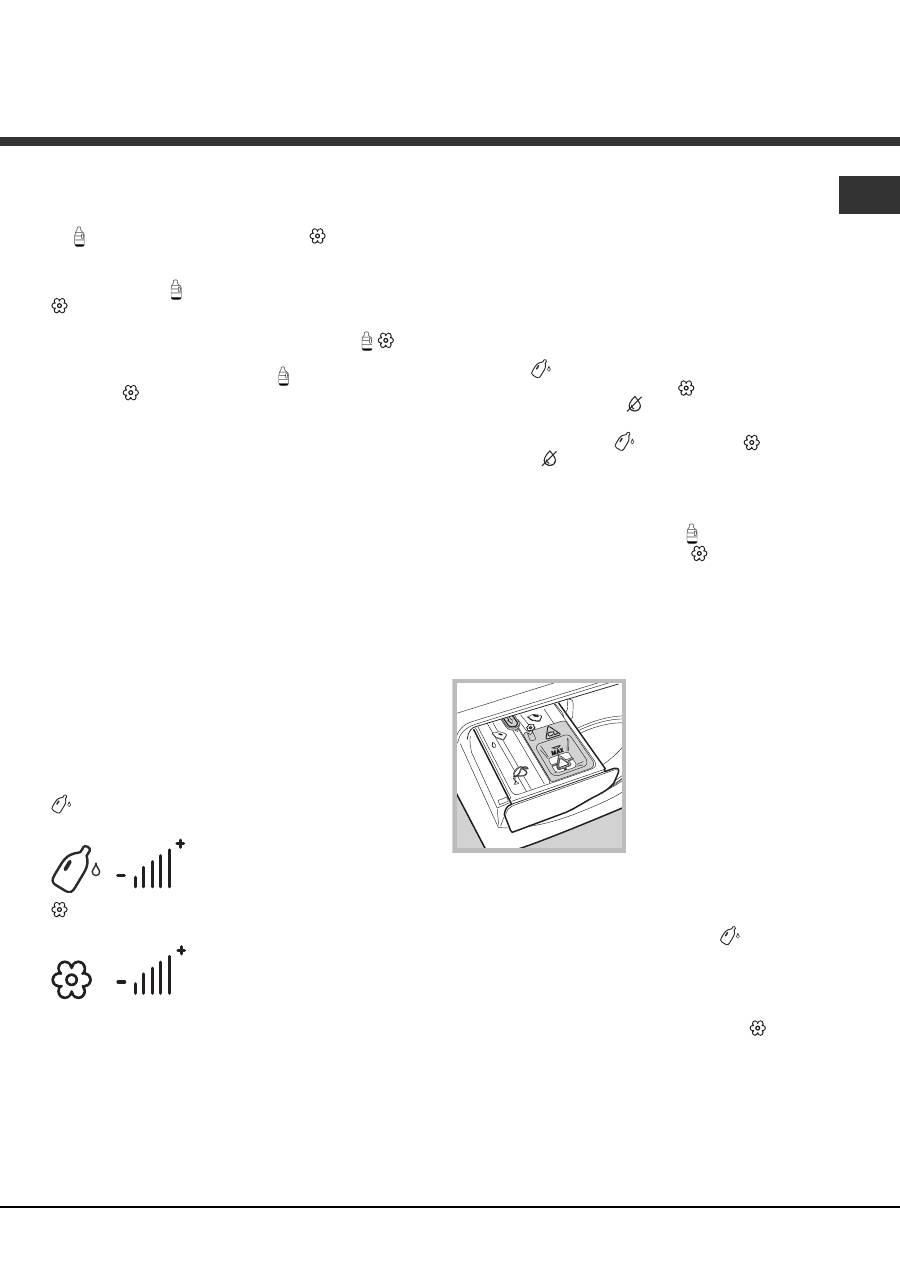
EN
7
Signals for successive refilling:
When the level of detergent/fabric softener falls below the
required level, at the end of the cycle, the first segment of
the detergent symbol or the petal of the fabric softener
symbol in the bottom left section, will flash slowly on the
display. Once the detergent/fabric softener is finished, the
first segment of the detergent symbol or the petal of the
fabric softener symbol in the lower left section will flash
fast to signal that the detergent or fabric softener tank is
empty. While the cycle runs, with empty tanks, the
symbols will disappear; at the end of the cycle or during the
pause mode, the first segment of the symbol and the
petal of the symbol in the lower left section will flash fast.
If the tanks are not filled, the successive wash cycles in
Auto Dose System
will be carried out without any intake of
detergent.
We suggest adding detergent and fabric softener ONLY
after the machine's signal
.
NEVER mix two different detergents; always clean out
the tank before adding a new type of detergent (refer to
"Cleaning cycle set by the user").
Using the "Auto Dose System"
If the compartments have been filled with detergent and
fabric softener, you may start using the machine (refer to
"
Running a wash cycle
").
Powder
detergents for pre-washing and
powder additives
may only be used in the traditional mode or using the "Auto
Dose System", by placing the additives directly inside the
drum, preferably in conjunction with the "laundry ball".
Modifying pre-set parameters:
The machine automatically intakes detergent on the
basis of the selected programme, wash load and water
hardness. However, the amount of detergent/fabric
softener used may be modified.
button: press to increase, decrease and to exclude
detergent intake.
button: press to increase, decrease and to exclude
fabric softener intake.
The level of detergent/fabric softener suggested by the
machine is indicated by 3 bars.
Less than 3 bars indicates a lower level of detergent/
fabric softener compared to that suggested by the
machine, while more than 3 bars indicates a higher level
of detergent/fabric softener.
Cleaning the tanks:
Tank cleaning cycles can either be automatic or pre-set
by the user.
Automatic cleaning:
The washing machine carries out an automatic cleaning
cycle during the rinse cycle if the level of detergent that
remains is insufficient for carrying out a
successive wash cycle.
Cleaning cycle set by the user:
Run the cleaning cycle (with empty drum) if you require
adding a different product to the previous one or if the tanks
have been incorrectly filled (e.g. fabric softener has been
erroneously poured into the detergent tank or vice-versa).
Press button
and hold for approximately 8 sec. to activate
cleaning of the detergent tank, button for cleaning the
fabric softener tank or button for cleaning both tanks.
Once the buzzers with growing intensity are followed by 2
long buzzers and the icons
for the detergent, for the
fabric softener, for both tanks appear, the cleaning cycle
for the selected container will start.
The cleaning cycle lasts about
40'
if the tanks are initially
empty; if not, the cycle will last longer.
During the tank cleaning cycle, the symbol will fill
gradually from bottom to top and the symbol will fill
gradually petal by petal.
"Traditional" mode
Pull out the detergent dispenser drawer up to the first
stop point
(see picture)
then pour the amount of
detergent and other additives (e.g. bleach) required for a
single wash cycle directly into the dispenser.
1. pre-wash compartment:
use powder detergent
only
.
2. main wash
compartment:
use powder
or liquid detergent. If the
latter is used, we
recommend pouring it into
the dispenser immediately
before starting the washing
machine and without
running a pre-wash cycle.
3.
!
Do not pour anything in this compartment.
Tablet detergent or the relative "laundry ball" must be
added directly inside the drum. In this event, deactivate
the "Auto Dose System" (by pressing the
button until
the relative vertical bars disappear from the display).
Do not pour any fabric softener as the appropriate
quantity required for each wash cycle will be
automatically extracted.
To deactivate fabric softener intake, press the button
until the vertical bars disappear from the display.
For wool and silk garments, we recommend using a
special detergent which must be poured directly into the
detergent dispenser (compartment 2).
Running the wash cycle:
Select the programme and the compatible options on
the basis of the required need and type of load.
3
1
2
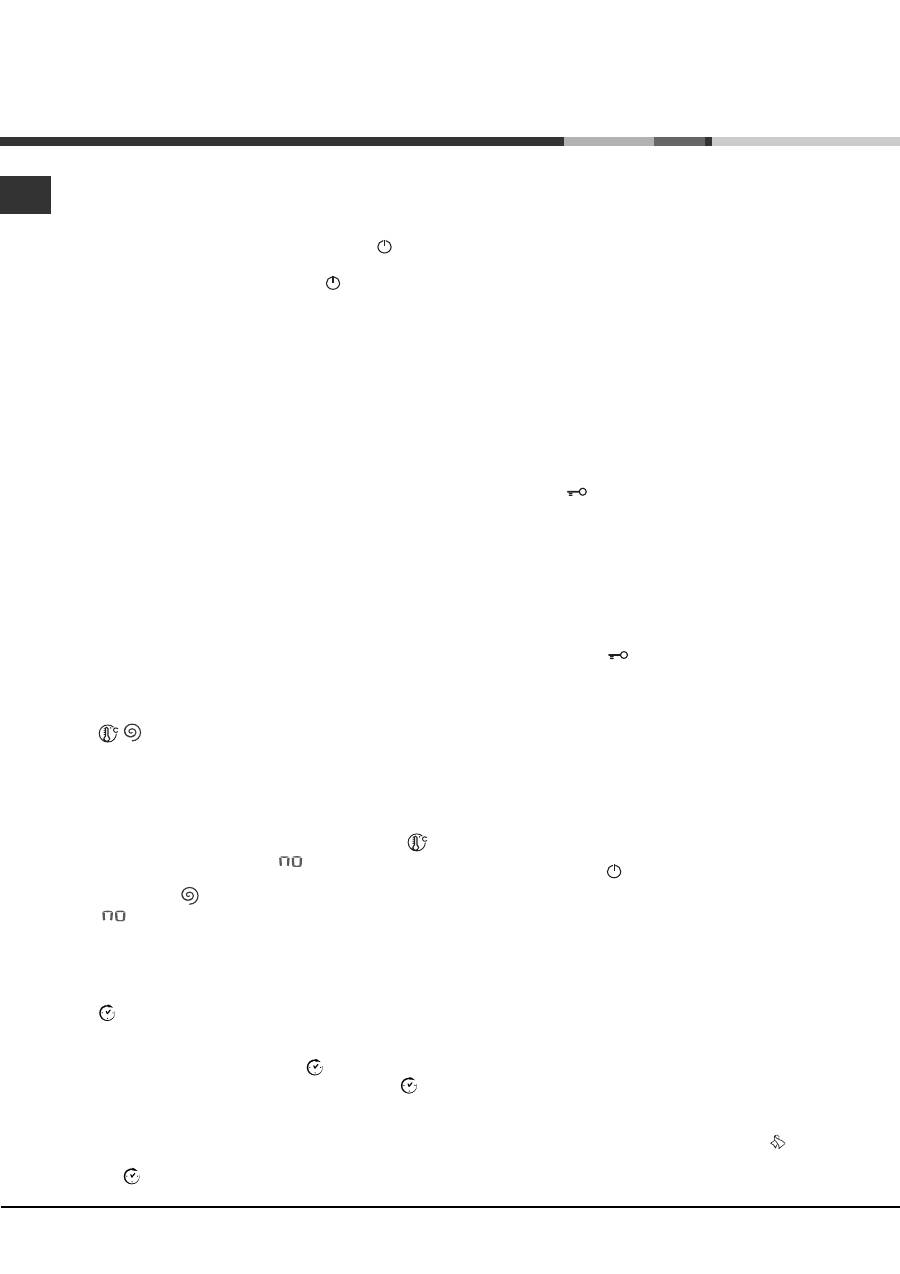
EN
8
Running a wash cycle
WARNING:
before you use the washing machine for
the first time, run a wash cycle with detergent and no
laundry, using the 90° cottons cycle without pre-wash.
1.
SWITCH THE MACHINE ON.
Press the button.
All the indicator lights will illuminate for 1 second; the
indicator light corresponding to the button will then
remain lit in a fixed manner and the START/PAUSE
indicator light will flash slowly.
2.
LOAD THE LAUNDRY
.
Open the porthole door.
Load the laundry, making sure you do not exceed the
maximum load value indicated in the table of wash
cycles on the following page.
3.
MEASURE OUT THE DETERGENT.
There is no
need to add detergent when the "
Auto Dose System
"
mode is used, as the machine automatically intakes
detergent on the basis of the selected programme,
type of load and water hardness. Refer to the
paragraph "
Traditional
mode for implementing the
traditional operation mode.
4.
CLOSE THE PORTHOLE DOOR.
5.
SELECT THE PROGRAMME.
Turn the WASH
CYCLE SELECTOR KNOB right or left, until you have
selected the desired wash cycle. A temperature and
spin speed is set for each wash cycle; these may be
adjusted.
6.
CUSTOMISE THE WASH CYCLE.
Use the
relevant buttons on the control panel:
Modify the temperature and/or spin
speed.
The machine automatically displays the maximum
temperature and spin speed values set for the
selected cycle, or the most recently-used settings if
they are compatible with the selected cycle. The
temperature can be decreased by pressing the
button, until the cold wash (
) setting is reached.
The spin speed may be progressively reduced by
pressing the button, until it is completely excluded
(
). If these buttons are pressed again, the
maximum values are restored.
Exception: if the
Cotton
programme is selected,
the temperature can be increased up to a value of
90°C.
Set a DELAY TIMER.
Press the button until you have reached the desired
delay time. During the setting process, the delay time
is shown on the display and the symbol flashes.
After selecting a DELAY TIMER time, the fixed
symbol and the cycle duration will appear on the
display. Press the button once to display the selected
delay time. To remove the DELAY TIMER option,
press the button until the display shows the text OFF;
the symbol will disappear.
Once the START/PAUSE button has been pressed,
the time delay may only be decreased.
Modify the cycle settings.
Press the OPTION button to customise the wash
cycle in accordance with your own requirements.
Press the button to activate the option; the
corresponding indicator light will switch on.
Press the button again to disable the option; the
indicator light will switch off.
If the selected option is not compatible with the
selected wash cycle, this incompatibility will be
signalled by the flashing of the indicator light and a
sound alert (3 beeps); the option will not be activated.
7.
START THE PROGRAMME.
Press the START/
PAUSE button. The corresponding indicator light
remains lit in a fixed manner and the porthole door
locks (the
DOOR LOCKED indicator light
illuminates). The icons corresponding to the wash
cycle phases will light up during the cycle to indicate
which phase is currently in progress. To change a
wash cycle once it has already started, pause the
washing machine by pressing the START/PAUSE
button; then select the desired cycle and press the
START/PAUSE button again. To open the door during
a wash cycle, press the START/PAUSE button; if the
DOOR LOCKED
indicator light is switched off you
may open the door. Press the START/PAUSE button
again to restart the wash cycle from the point at
which it was interrupted.
8.
THE END OF THE WASH CYCLE.
This is indicated
by the illuminated text
END
. The porthole door may
be opened immediately. If the START/PAUSE indicator
light is flashing, press the button to end the cycle.
Open the door, unload the laundry and switch off the
machine.
If you wish to cancel a cycle which has already begun,
press and hold the button until the cycle stops and
the machine switches off.
Bag for quilts, curtains and delicate garments
The Aqualtis washing machine makes it easier for you to
wash even the most valuable and delicate garments in
complete confidence thanks to the special bag which
protects the laundry (this is supplied with the machine).
We recommend that the bag is used every time you
wash quilts and padded items with an outer layer made
using synthetic material.
Anti-crease
This function interrupts the wash programme, and the
washing is left to soak in water before the appliance is
drained.
It is automatically activated with programme
(Silk) and
helps to prevent the formation of creases. To complete
the cycle press the START/PAUSE button.
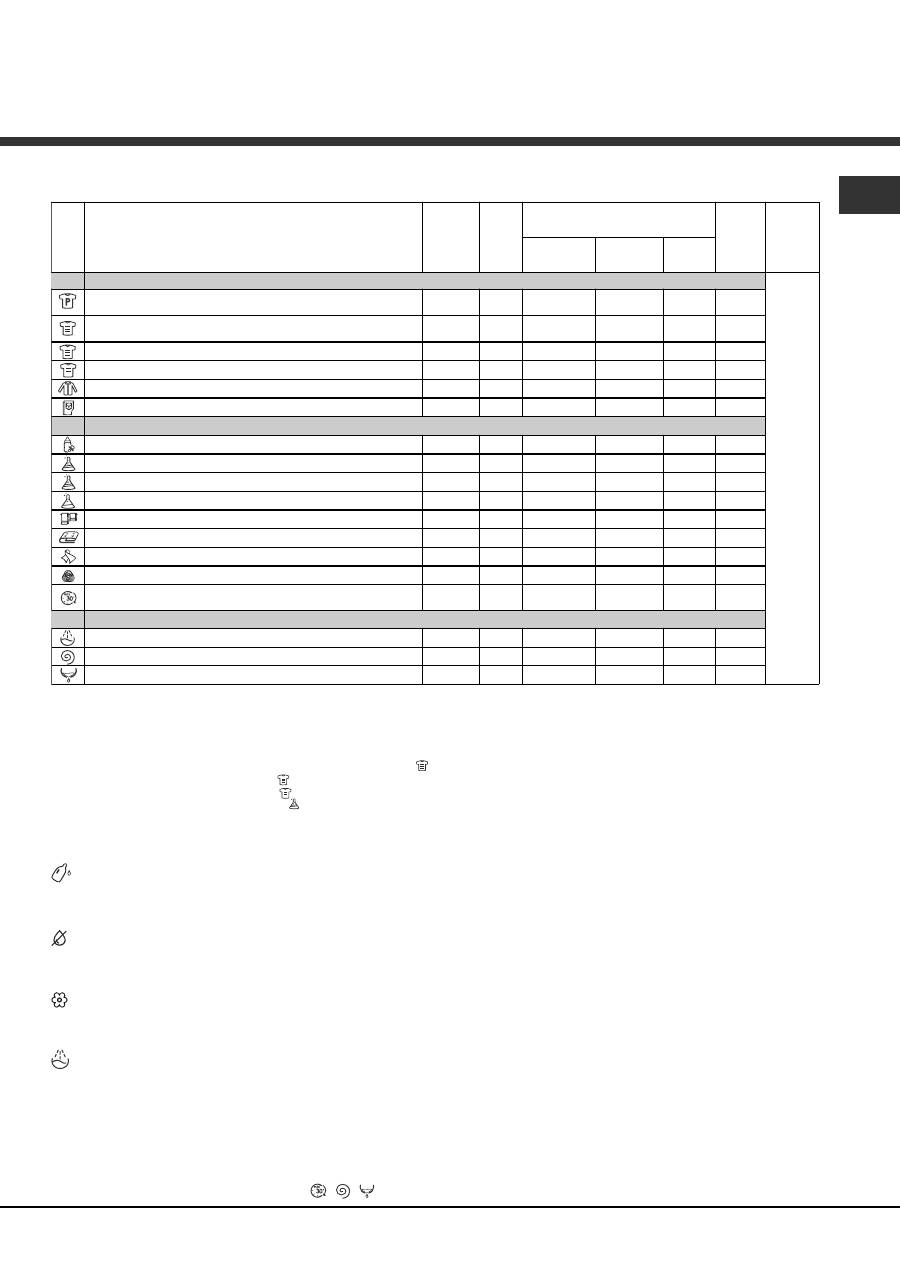
EN
9
Options
Detergent dosage
To dose the amount of detergent (refer to the chapter
"
Auto Dose System
").
Concentrated Detergent
To modify the degree of detergent density (refer to the
chapter "
Auto Dose System
").
Fabric softener dosage
To dose the amount of fabric softener (refer to the
chapter "
Auto Dose System
").
Extra rinse
By selecting this option, the efficiency of the rinse is
increased and optimal residual detergent removal is
guaranteed. It is particularly useful for skin which is
sensitive to detergents. We recommend this option is
used with a full load of washing, or when a large amount
of detergent is required.
It cannot be used in conjunction with
, , .
(*)
The
duration
of
the
wash
cycles
can
be
checked
on
the
display
.
(*) Note: 10 minutes after the START, the machine will recalculate the time remaining until the end of the wash cycle on the basis of the load inside it; this
value will then be shown on the display.
Wash cycles and options
Table of wash cycles
Icon Description of the wash cycle
Max.
temp.
(°C)
Max.
speed
(rpm)
Detergent and additives
Max.
load
(kg)
Cycle
duration
Detergent
for prewash
Detergent
for wash
Fabric
softener
Cottons wash cycles
Cotton
with pre-wash
(Add detergent to the relevant compartment).
90°
1200
l
l
l
8
Cotton (1-2):
heavily soiled whites and resistant colours.
60°
(Max. 90°) 1200
-
l
l
8
Cotton (2):
heavily soiled whites and delicate colours.
40°
1200
-
l
l
8
Coloured
Cotton (3)
40°
1200
-
l
l
8
Shirts
40°
600
-
l
l
2
Jeans
40°
800
-
l
l
4
Special programmes
Baby:
heavily soiled delicate colours
40°
800
-
l
l
4
Durable
Synthetics
60°
800
-
l
l
4
Durable
Synthetics (4)
40°
800
-
l
l
4
Delicate
Synthetics
40°
800
-
l
l
4
"Bed & Bath"
for bedlinen and towels.
60°
1200
-
l
l
8
Duvets:
for down-stuffed garments.
30°
1000
-
l
l
3,5
Silk:
for garments in silk and viscose, lingerie.
30°
0
-
l
l
2
Wool:
for wool, cashmere, etc.
40°
800
-
l
l
2
Mix 30':
to refresh lightly soiled garments quickly (not suitable
for wool, silk and clothes which require washing by hand)
30°
800
-
l
l
3,5
Partials wash cycles
Rinse
-
1200
-
-
l
8
Spin
-
1200
-
-
-
8
Drain
-
0
-
-
-
8
The length of cycle shown on the display or in this booklet is an estimation only and is calculated assuming standard working conditions. The actual duration can vary according to factors such as
water temperature and pressure, the amount of detergent used, the amount and type of load inserted, load balancing and any wash options selected.
For all Test Institutes:
1) Test wash cycle in compliance with regulation 2010/1061: set wash cycle with a temperature of 60°C and 40°C.
2) Long wash cycle for cottons: set wash cycle with a temperature of 40°C.
3) Short wash cycle for cottons: set wash cycle with a temperature of 40°C.
4) Long wash cycle for synthetics: set wash cycle with a temperature of 40°C.
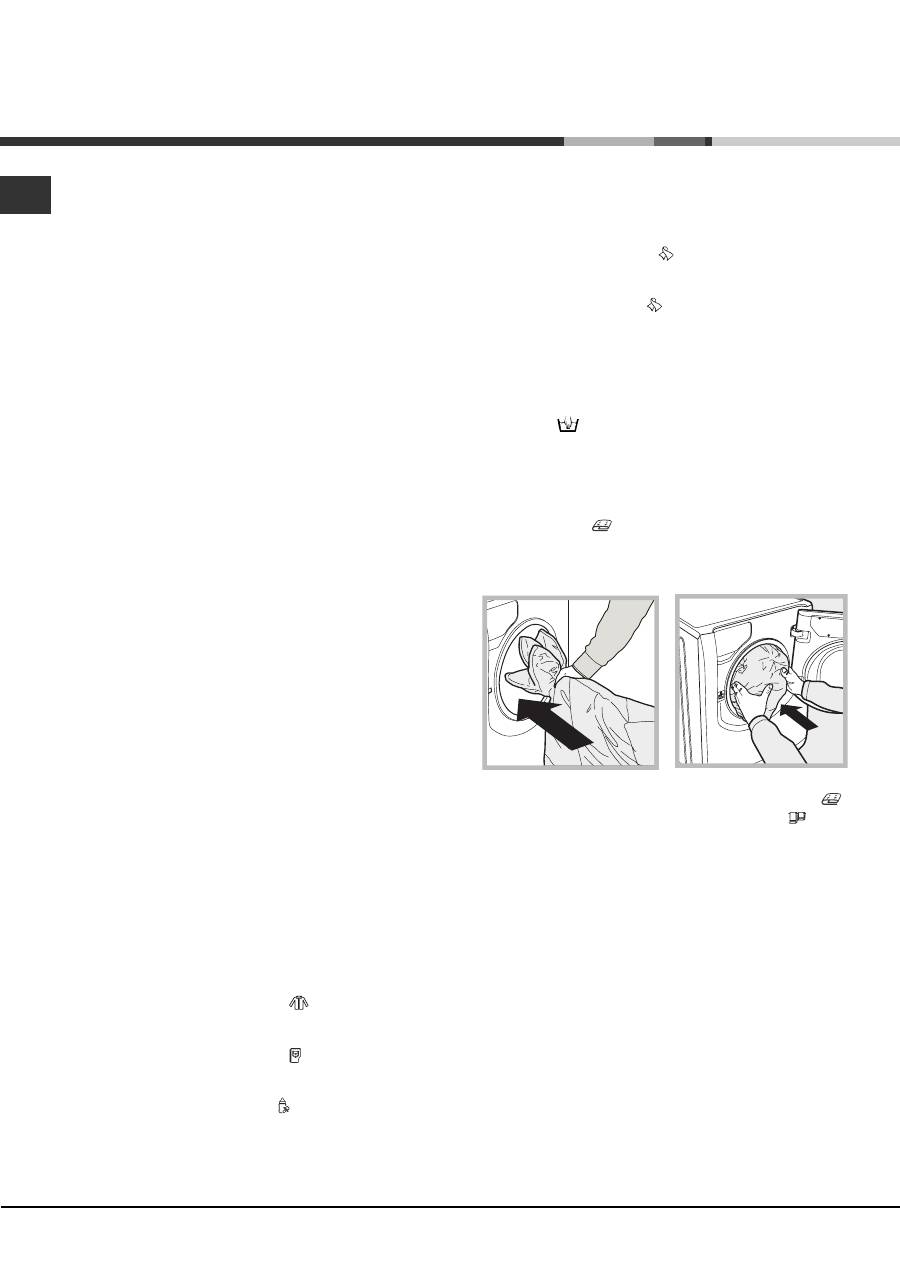
EN
10
Detergents and laundry
Detergent
The type and quantity of detergent required depend on
the type of fabric you are washing (cotton, wool, silk,
etc.), as well as its colour, the washing temperature, the
level of soiling and the hardness of the water in the area.
Whenever the detergent and fabric softener
Auto Dose
System
is activated, this washing machine helps to
prevent wastage and to protect the environment,
besides guaranteeing optimal washing performance.
We recommend the following:
Use powder detergent for carrying out a pre-wash
and pour in the "
traditional
" mode.
Use liquid detergents for delicate cotton garments and
for all low-temperature wash cycles.
When activating the "
Auto Dose System
" mode, use
liquid detergent and fabric softeners only.
Never add
ultra-concentrated detergents (e.g. "Gel" type
detergents or similar)
.
Use gentle liquid detergents for wool and silk
garments and pour in the "
traditional
" mode.
Never
mix two different detergents; always clean out
the tank before adding a new type of detergent.
The detergent should be poured into the relevant
compartment - or the dispenser placed directly inside the
drum - before the wash cycle begins. In the latter case, it will
not be possible to select the Cottons with pre-wash cycle.
Do not use hand washing detergents because these
create too much foam.
Preparing the laundry
Shake out the garments before loading them into the
machine.
Divide the laundry according fabric type (symbol on the
washing instruction label) and colour, making sure you
separate the coloured garments from the white ones;
Empty all pockets and check the buttons;
Do not exceed the values listed in the
Table of wash
cycles
, which refer to the weight of the laundry when dry.
How much does your laundry weigh?
1 sheet
400-500 g
1 pillowcase
150-200 g
1 tablecloth
400-500 g
1 bathrobe
900-1200 g
1 towel
150-250 g
1 pair of jeans
400-500 g
1 shirt
150-200 g
Washing recommendations
Shirts:
use the special Shirts
wash cycle to wash
shirts in different fabrics and colours to guarantee they
receive the best possible care.
Jeans:
use the special Jeans wash cycle for all
denim garments; turn inside out before washing and use
a liquid detergent.
Baby:
use the special Baby wash cycle to remove
the remove the soiling typically caused by babies, while
removing all traces of detergent from nappies in order to
prevent the delicate skin of babies from suffering allergic
reactions. The cycle has been designed to reduce the
amount of bacteria by using a greater quantity of water
and optimising the effect of special disinfecting additives
added to the detergent. At the end of the wash cycle,
the machine will slowly rotate the drum; to end the cycle
press the START/PAUSE button.
Silk:
use the special Silk wash cycle to wash all silk
garments. We recommend the use of special detergent
which has been designed to wash delicate clothes.
Curtains:
use the Silk wash cycle. These should
be folded and placed inside the bag provided.
Wool:
is the only washing machine brand to have been
awarded the prestigious Woolmark Platinum Care
endorsement (M.0508) by the Woolmark Company,
which means that all woollen garments may be washed
in the washing machine, even those which state hand
wash only
on the label. The Wool wash cycle can
be used to wash all woollen garments in the washing
machine while guaranteeing optimum performance.
Duvets:
to wash double or single duvets (the weight of
which should not exceed 3,5 kg), cushions or clothes
padded with goose down such as puffa jackets, use the
special Duvets
wash cycle. We recommend that
duvets are placed in the drum with their edges folded
inwards
(see figure)
and that no more than
¾
of the total
volume of the drum is used.
Quilts:
to wash quilts with a synthetic outer layer, use
the bag provided and set the wash cycle to Duvets
.
Bedlinen and towels:
use the Bed & Bath
cycle
to wash laundry from all over the house; this optimises
fabric softener performance and helps you save time and
energy. We recommend the use of powder detergent.
Stubborn stains:
it is wise to treat stubborn stains with
solid soap before washing, and to use the Cottons with
pre-wash cycle.
Load balancing system
Before every spin cycle, to avoid excessive vibrations
before every spin and to distribute the load in a uniform
manner, the drum rotates continuously at a speed which
is slightly greater than the washing rotation speed. If,
after several attempts, the load is not balanced
correctly, the machine spins at a reduced spin speed. If
the load is excessively unbalanced, the washing
machine performs the distribution process instead of
spinning. To encourage improved load distribution and
balance, we recommend small and large garments are
mixed in the load.
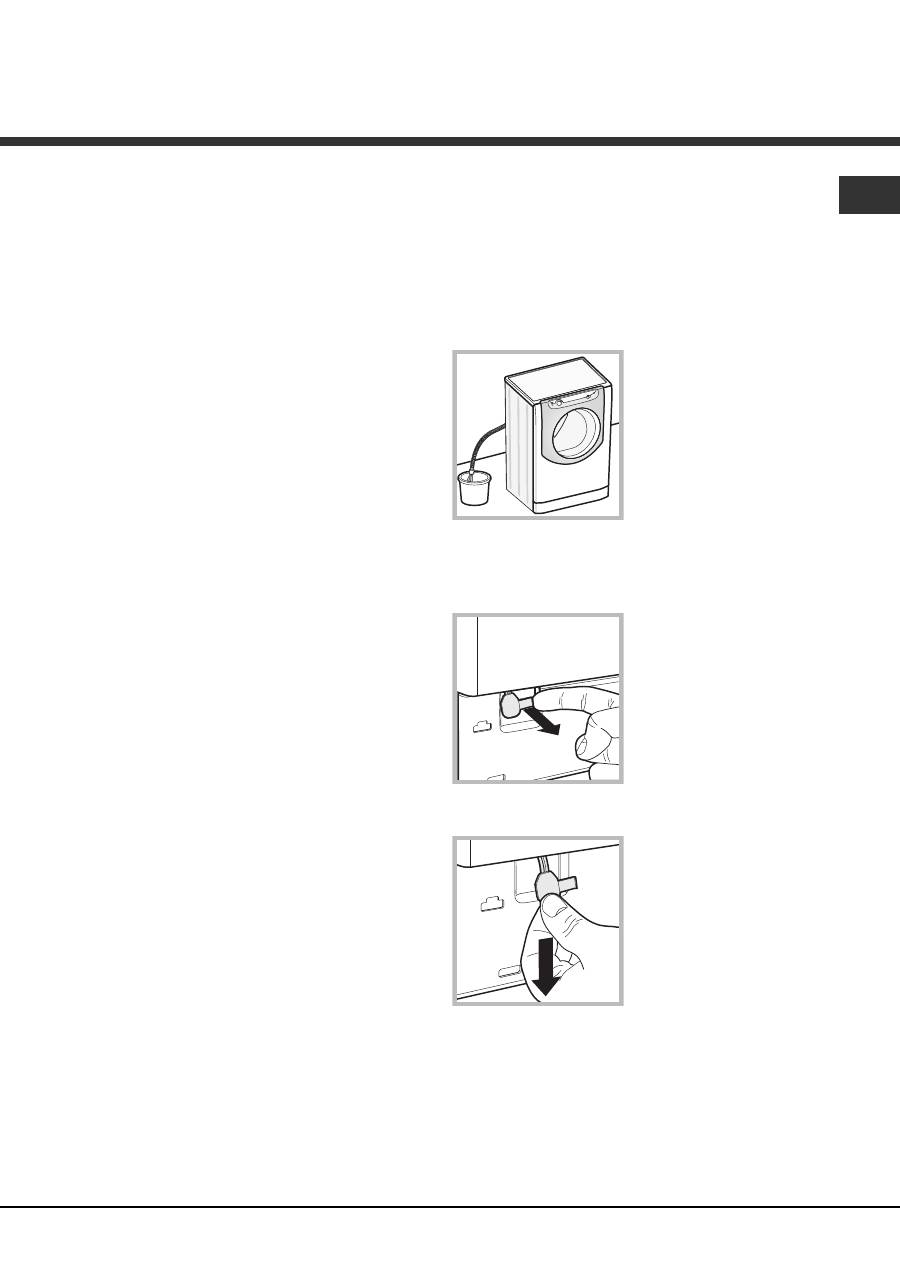
EN
11
Precautions and tips
The machine was designed and constructed in
accordance with international safety regulations. The
following information is provided for safety reasons and
must therefore be read carefully.
General safety
This appliance is not intended for use by persons
(including children) with reduced physical, sensory or
mental capabilities, or lack of experience and
knowledge, unless they have been given supervision
or instruction concerning use of the appliance by a
person responsible for their safety. Children should be
supervised to ensure that they do not play with the
appliance.
This appliance was designed for domestic use only.
Do not touch the machine when barefoot or with wet
or damp hands or feet.
Do not pull on the power supply cable when
unplugging the appliance from the electricity socket.
Hold the plug and pull.
Do not touch the drained water as it may reach
extremely high temperatures.
Never force the porthole door. This could damage the
safety lock mechanism designed to prevent
accidental opening.
If the appliance breaks down, do not under any
circumstances access the internal mechanisms in an
attempt to repair it yourself.
Always keep children well away from the appliance
while it is operating.
If it must be moved, proceed with the help of two or
three people and handle it with the utmost care.
Never try to do this alone, because the appliance is
very heavy.
Before loading laundry into the washing machine,
make sure the drum is empty.
Disposal
Disposing of the packaging materials: observe local
regulations so that the packaging may be re-used.
The European Directive 2002/96/EC relating to Waste
Electrical and Electronic Equipment (WEEE) states
that household appliances should not be disposed of
using the normal solid urban waste cycle. Exhausted
appliances should be collected separately in order to
optimise the cost of re-using and recycling the
materials inside the machine, while preventing
potential damage to the atmosphere and to public
health. The crossed-out dustbin is marked on all
products to remind the owner of their obligations
regarding separated waste collection.
For more information relating to the correct disposal of
household appliances, owners should contact their
local authorities or appliance dealer.
Opening the porthole door manually
In the event that it is not possible to open the porthole
door due to a powercut, and if you wish to remove the
laundry, proceed as follows:
1. remove the plug from the
electrical socket.
2. make sure the water level
inside the machine is lower
than the door opening; if it is
not, remove excess water
using the drain hose,
collecting it in a bucket as
indicated in the
figure
.
3. remove the cover panel on the lower front part of the
washing machine (
see overleaf
).
4. pull outwards using the
tab as indicated in the figure,
until the plastic tie-rod is
freed from its stop position;
pull downwards until you
hear a click, which
indicates that the door is
now unlocked.
5. open the door; if this is
still not possible repeat the
procedure.
6. reposition the panel, making sure the hooks are
securely in place before you push it onto the appliance.
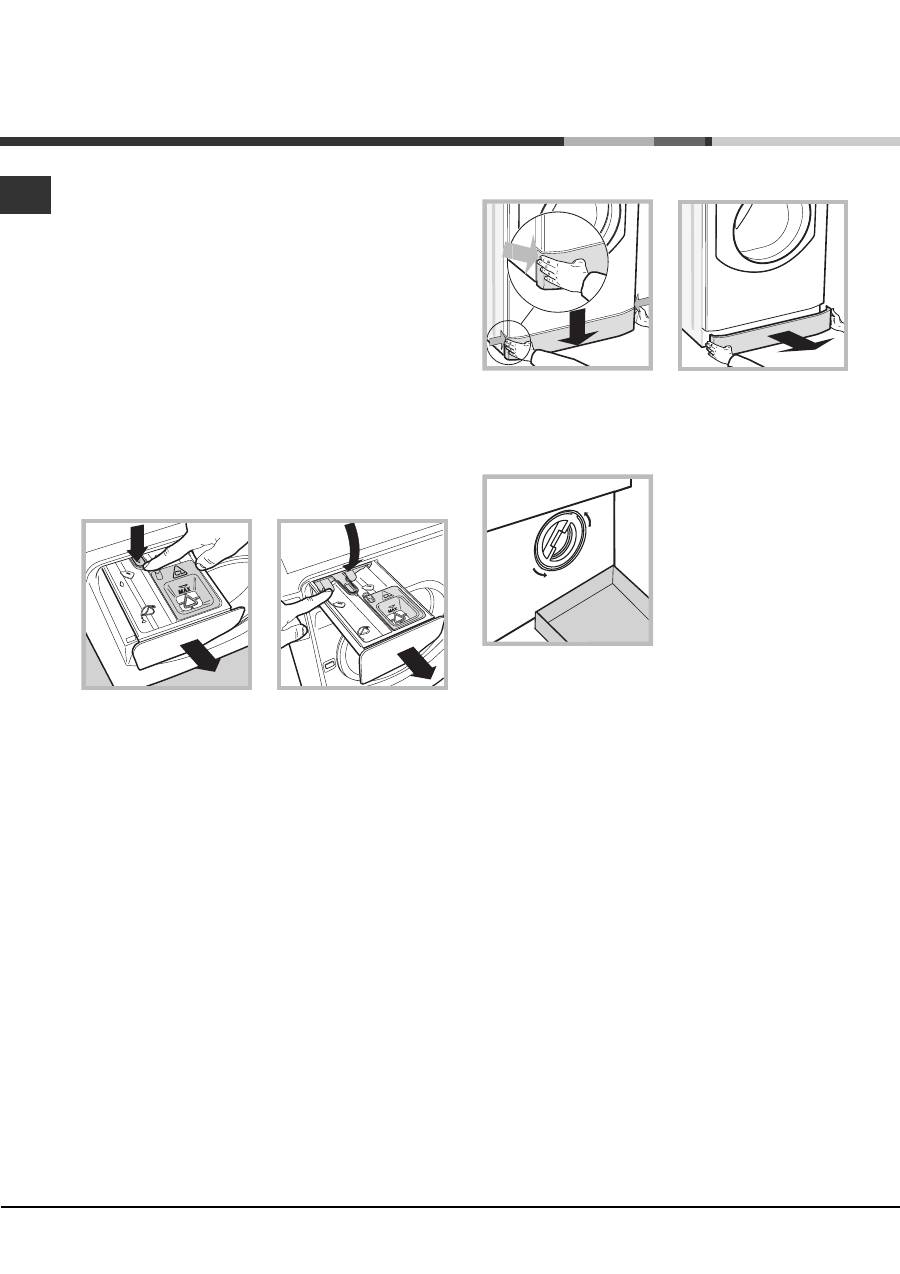
EN
12
Care and maintenance
Cutting off the water and electricity
supplies
Turn off the water tap after every wash cycle. This will
limit wear on the hydraulic system in the machine and
help to prevent leaks.
Unplug the appliance when cleaning it and during all
maintenance work.
Cleaning the machine
The outer parts and rubber components of the appliance
can be cleaned using a soft cloth soaked in lukewarm
soapy water. Do not use solvents or abrasives.
Cleaning the detergent dispenser drawer
To pull out the dispenser drawer, open until the first stop
point then press lever
A
to open completely; finally, press
one of the levers
D
and pull the drawer outwards
(see
picture).
Wash it under running water; this procedure should be
effected regularly. Be careful to remove any detergent
residues from the dispenser drawer socket on the
machine.
Keep the drawer to the left hand side when replacing it
to ensure that it centres the guides and to prevent it
from jamming.
Caring for your appliance drum
Always leave the door ajar to prevent unpleasant
odours from forming.
Cleaning the pump
The washing machine is fitted with a self-cleaning pump
which does not require any maintenance. Sometimes,
small items (such as coins or buttons) may fall into the
protective pre-chamber at the base of the pump.
Make sure the wash cycle has finished and unplug the
appliance.
To access the pre-chamber:
1. take off the cover panel on the front of the machine
by first pressing it in the centre and then pushing
downwards on both sides until you can remove it
(see
figures);
2. position a container so
that it will collect the water
which flows out
(approximately 1.5 l) (
see
figure
)
;
3. unscrew the lid by
rotating it in an anti-
clockwise direction (
see
figure
)
;
4. clean the inside thoroughly;
5. screw the lid back on;
6. reposition the panel, making sure the hooks are
securely in place before you push it onto the appliance.
Checking the water inlet hose
Check the inlet hose at least once a year. If there are
any cracks, it should be replaced immediately: during
the wash cycles, water pressure is very strong and a
cracked hose could easily split open.
1
2
A
D

EN
13
Trouble shooting
Your washing machine could occasionally fail to work. Before contacting the Technical Assistance Centre
(
see Assistance
), make sure that the problem cannot be not solved easily using the following list.
Problem:
The washing machine does not
switch on.
The wash cycle does not start.
The washing machine does not fill
with water.
The machine continuously fills
with water and drains.
The washing machine does not
drain or spin.
The machine vibrates a lot during
the spin cycle.
The washing machine leaks.
The icons corresponding to the
Phase in progress flash rapidly
at the same time as the ON/OFF
indicator light.
There is too much foam.
The washing machine door
remains locked.
Possible causes / Solutions:
The appliance is not plugged into the socket fully, or not enough to make
contact.
There is no power in the house.
The door is not closed properly.
The START/PAUSE button has not been pressed.
The water tap has not been opened.
A DELAY TIMER has been set
.
The water inlet hose is not connected to the tap.
The hose is bent.
The water tap has not been opened.
There is no water supply in the house.
The pressure is too low.
The START/PAUSE button has not been pressed.
The drain hose is not fitted at a height between 65 and 100 cm from the
floor (
see Installation).
The free end of the hose is under water (
see Installation).
If the dwelling is on one of the upper floors of a building, there may be
problems relating to water drainage, causing the washing machine to fill
with water and drain continuously. Special anti-draining valves are available
in shops and help to prevent this inconvenience.
The wall drainage system is not fitted with a breather pipe.
The wash cycle does not include draining: Some wash cycles require the
drain phase to be started manually (
see Wash cycles and options
).
The drain hose is bent (
see Installation
).
The drainage duct is clogged.
The drum was not unlocked correctly during installation (
see Installation).
The machine is not level (
see Installation
).
The machine is trapped between cabinets and walls (
see Installation).
The load is unbalanced (
see Detergents and laundry
).
The water inlet hose is not screwed on properly (see
Installation
).
The detergent dispenser is blocked (to clean it,
see Care and
maintenance
).
The drain hose is not fixed in place properly (see
Installation
).
Switch off the machine and unplug it, wait for approximately 1 minute and
then switch it back on again. If the problem persists, contact the Technical
Assistance Service.
The detergent is not suitable for machine washing (it should display the text
for washing machines or hand and machine wash, or the like).
Too much detergent was used.
Perform the manual unlocking procedure (
see Precautions and tips).

EN
14
Troubleshooting:
The machine's washing
performance is unsatisfactory.
What happens if the tanks are
loaded even if they are already full?
What happens if the dispenser is
used in the traditional mode while
the tanks are still full?
Can the tanks also be used for
powder detergent?
Can powder detergent fall into the
tanks?
What happens if the dispenser is
not opened properly when filling the
tanks?
What happens if detergent and
fabric softener are erroneously
inverted?
What happens if different
detergents are mixed before the
tanks are empty?
Possible causes / Solutions:
The tanks have not been loaded correctly (e.g. fabric softener has been
added instead of detergent or vice-versa)
Two different types of detergent/fabric softener have mixed.
NEVER mix two different detergents; always clean out the tanks before adding
a new type of detergent.
The "
Auto Dose System
is blocked due to prolonged lack of use: carry
out a tank cleaning cycle (refer to "
Cleaning cycle pre-set by user
").
Buzzers (Beep) and visual signals (icons appearing on the display) indicate
that the tank is full. If further detergent/fabric softener is added, the excess
quantity will fall into the drum and will be washed away with the next cycle.
The machine will automatically track whether powder or liquid detergent
has been loaded in the traditional mode and will not intake any amount of
detergent from the tank. Fabric softener can only be used in the "
Auto
Dose System
mode.
No, powder detergent can only be used in the traditional mode.
No, there is a barrier to prevent powder detergent from falling into one of
the tanks even if the dispenser is open in the "
Auto Dose System
" position
(i.e. completely open).
If the dispenser is not completely open, the detergent or fabric softener
that has been added will fall into the drum and will be washed away with
the next cycle.
The washing machine will wash with unsatisfactory results, the tanks will
have to be emptied and subjected to a manual cleaning cycle.
The machine will wash normally although we recommend only refilling the
tanks after the signal emitted by the machine; do not mix different
detergents/fabric softeners.
Note:
To exit Demo mode, press and hold the two ON/OFF and START/PAUSE buttons simultaneously for 3 seconds.

EN
15
Assistance
Before calling for Assistance:
Check whether you can solve the problem by yourself (see
Trouble shooting
);
Restart the wash cycle to check whether the problem has been solved;
If it has not, contact the Authorised Technical Assistance Service.
If the washing machine has been installed or used incorrectly, you will have to pay for the call-out service.
Always request the assistance of authorised technicians.
Please have the following information to hand:
the type of problem;
the appliance model (Mod.);
the serial number (S/N).
The above information can be found on the data plate located on the appliance itself.

EN
16

17
I
Italiano
Sommario
Installazione, 18-19
Disimballo e livellamento
Collegamenti idraulici ed elettrici
Dati tecnici
Descrizione della macchina, 20-21
Pannello comandi
Auto Dose System, 22-23
Come effettuare un ciclo di lavaggio, 24
Programmi e opzioni, 25
Tabella Programmi
Le opzioni di lavaggio
Detersivi e biancheria, 26
Detersivo
Preparare la biancheria
Consigli di lavaggio
Sistema bilanciamento del carico
Precauzioni e consigli, 27
Sicurezza generale
Smaltimento
Apertura manuale della porta oblò
Manutenzione e cura, 28
Escludere acqua e corrente elettrica
Pulire la macchina
Pulire il cassetto dei detersivi
Curare il cestello
Pulire la pompa
Controllare il tubo di alimentazione dellacqua
Anomalie e rimedi, 29
Assistenza, 30
Assistenza Attiva 7 giorni su 7
I
LAVABIANCHERIA
AQUALTIS
AQLF8F 292 U
Istruzioni per
linstallazione e luso
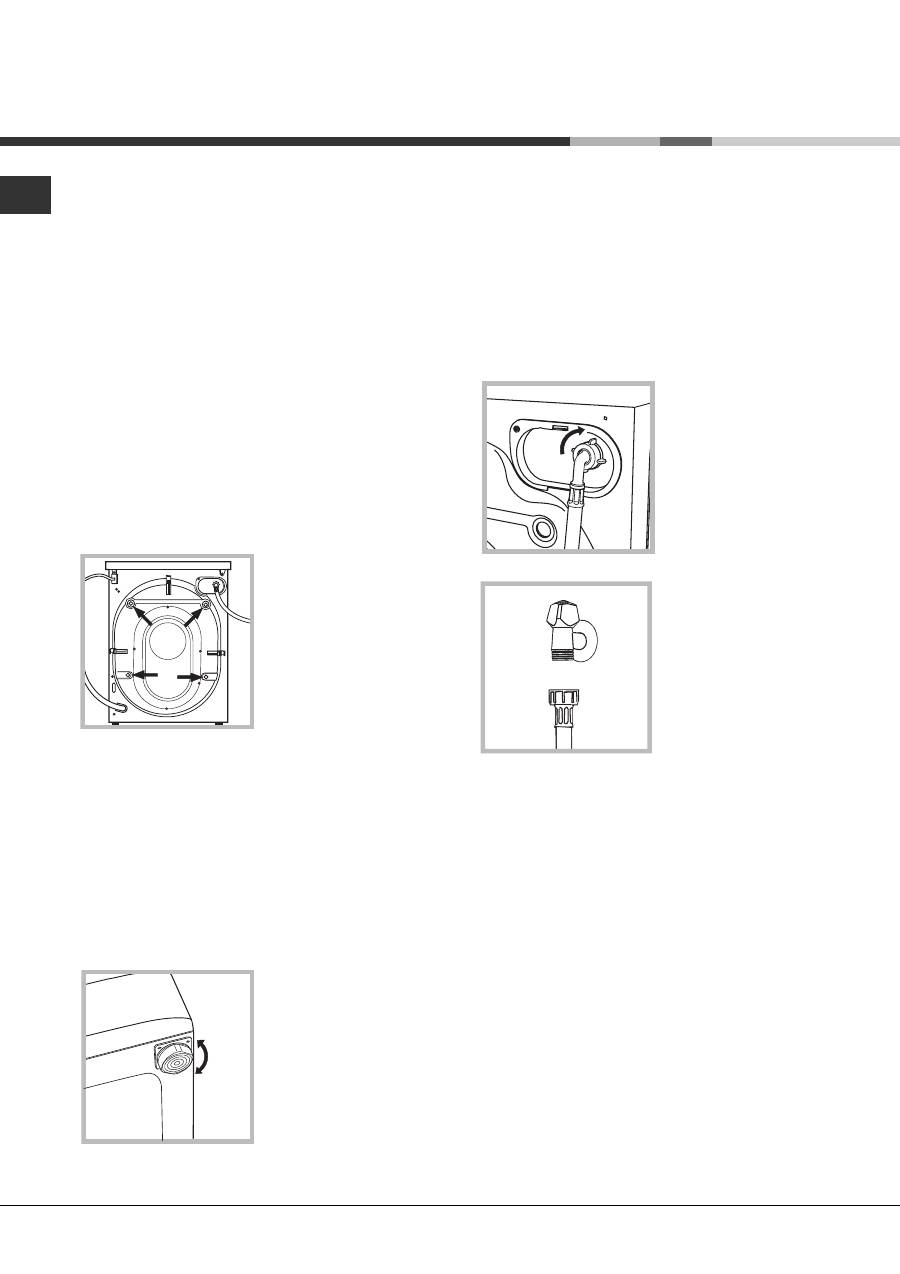
18
I
E importante conservare questo libretto per
poterlo consultare in ogni momento. In caso di
vendita, di cessione o di trasloco, assicurarsi che
resti insieme alla lavabiancheria.
Leggere attentamente le istruzioni: ci sono importanti
informazioni sullinstallazione, sulluso e sulla
sicurezza.
Nella busta contenente questo libretto troverete,
oltre alla garanzia, dei particolari che serviranno per
linstallazione.
Disimballo e livellamento
Disimballo
1. Una volta disimballata la lavabiancheria, controllare
che non abbia subito danni durante il trasporto.
Se fosse danneggiata non collegarla e contattare
il rivenditore.
2. Rimuovere le 4 viti di
protezione per il
trasporto ed il relativo
distanziale posti nella
parte posteriore (
vedi
figura
).
3. Chiudere i fori con i tappi di plastica contenuti nella
busta.
4. Conservare tutti i pezzi;
qualora la lavabiancheria
dovesse essere trasportata, dovranno essere
rimontati per evitare danneggiamenti interni.
Gli imballaggi non sono giocattoli per bambini.
Livellamento
1. Posizionare la lavabiancheria su un pavimento
piano e rigido, senza appoggiarla a muri o mobili.
2. Compensare le
irregolarità svitando o
avvitando i piedini finchè
la macchina non sia
orizzontale (non deve
essere inclinata più di 2
gradi).
Un accurato livellamento dà stabilità ed evita vibrazioni
e rumorosità soprattutto nella fase di centrifuga.
In caso sia posizionata su moquette o tappeti,
regolare i piedini in modo da conservare sotto la
lavabiancheria lo spazio necessario per la ventilazione.
Collegamenti idraulici ed elettrici
Collegamento del tubo di alimentazione dellacqua
Prima di collegare il tubo di alimentazione alla rete
idrica, far scorrere l'acqua finché non sia limpida.
1. Collegare il tubo di
alimentazione alla
macchina avvitandolo
all'apposita presa
d'acqua, nella parte
posteriore in alto a
destra
(vedi figura).
2. Collegare il tubo di
alimentazione
avvitandolo a un
rubinetto d'acqua fredda
con bocca filettata da
3/4 gas
(vedi figura)
.
3. Fare attenzione che nel tubo non ci siano né pieghe
né strozzature.
La pressione idrica del rubinetto deve essere
compresa nei valori della tabella Dati tecnici
(vedi pagina a fianco).
Se la lunghezza del tubo di alimentazione non fosse
sufficiente, rivolgersi a un negozio specializzato o a un
tecnico autorizzato.
Non utilizzare mai tubi di carico usati o vecchi, ma
quelli in dotazione alla macchina.
Installazione
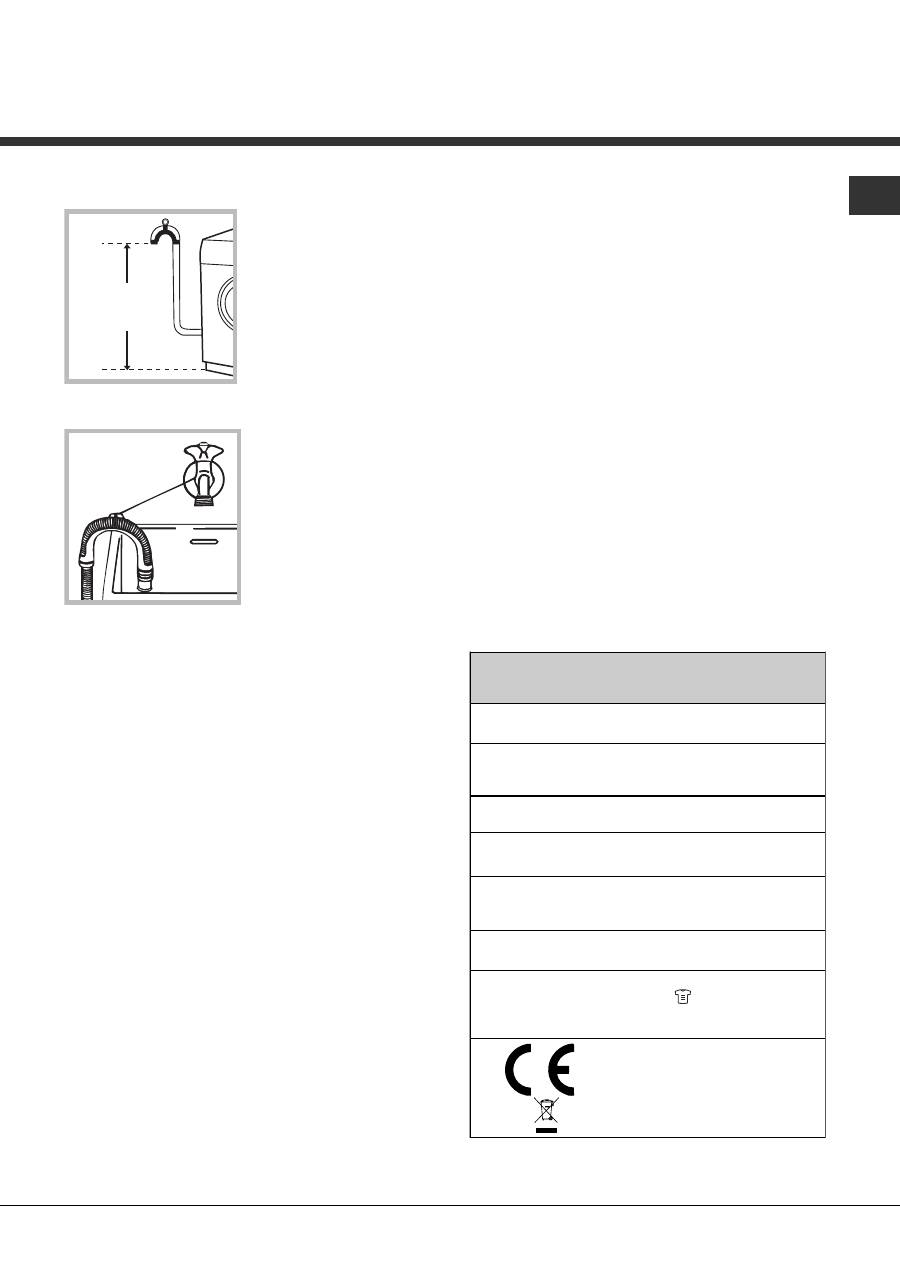
19
I
Dati tecnici
Modello
AQLF8F 292 U
Dimensioni
larghezza cm 59,5
altezza cm 85
profondità cm 64,5
Capacità
da 1 a 8 kg
Collegamenti
elettrici
vedi la targhetta caratteristiche
tecniche applicata sulla macchina
Collegamenti
idrici
pressione massima 1 MPa (10 bar)
pressione minima 0,05 MPa (0,5 bar)
capacità del cesto 62 litri
Velocità di
centrifuga
sino a 1200 giri al minuto
Programmi di
controllo secondo
la norma
2010/1061
programma
; temperatura 60°C e
40°C.
Questa apparecchiatura è conforme
alle seguenti Direttive Comunitarie:
- 2004/108/CE (Compatibilità
Elettromagnetica)
- 2002/96/CE
- 2006/95/CE (Bassa Tensione)
Collegamento del tubo di scarico
Collegare il tubo di
scarico a una conduttura
di scarico o a uno
scarico a muro posti tra
65 e 100 cm da terra
evitando assolutamente
di piegarlo.
In alternativa,
appoggiare il tubo di
scarico al bordo di un
lavandino o di una
vasca, legando la guida
in dotazione al rubinetto
(vedi figura).
L'estremità libera del
tubo di scarico non
deve rimanere immersa
nell'acqua.
È sconsigliato usare tubi di prolunga; se
indispensabile, la prolunga deve avere lo stesso
diametro del tubo originale e non superare i 150 cm.
Collegamento elettrico
Prima di inserire la spina nella presa della corrente,
accertarsi che:
la presa abbia la messa a terra e sia a norma
di legge;
la presa sia in grado di sopportare il carico
massimo di potenza della macchina, indicato
nella targhetta caratteristiche
;
la tensione di alimentazione sia compresa nei
valori indicati nella targhetta caratteristiche;
la presa sia compatibile con la spina della
macchina. In caso contrario far sostituire la presa o
la spina.
La macchina non va installata all'aperto, nemmeno
se lo spazio è riparato, perché è molto pericoloso
lasciarla esposta a pioggia e temporali.
A macchina installata, la presa della corrente deve
essere facilmente raggiungibile.
Non usare prolunghe e multiple.
Il cavo non deve subire piegature o compressioni.
Il cavo di alimentazione e la spina devono essere
sostituiti solo da tecnici autorizzati.
Attenzione! Lazienda declina ogni responsabilità
qualora queste norme non vengano rispettate.
65 - 100 cm
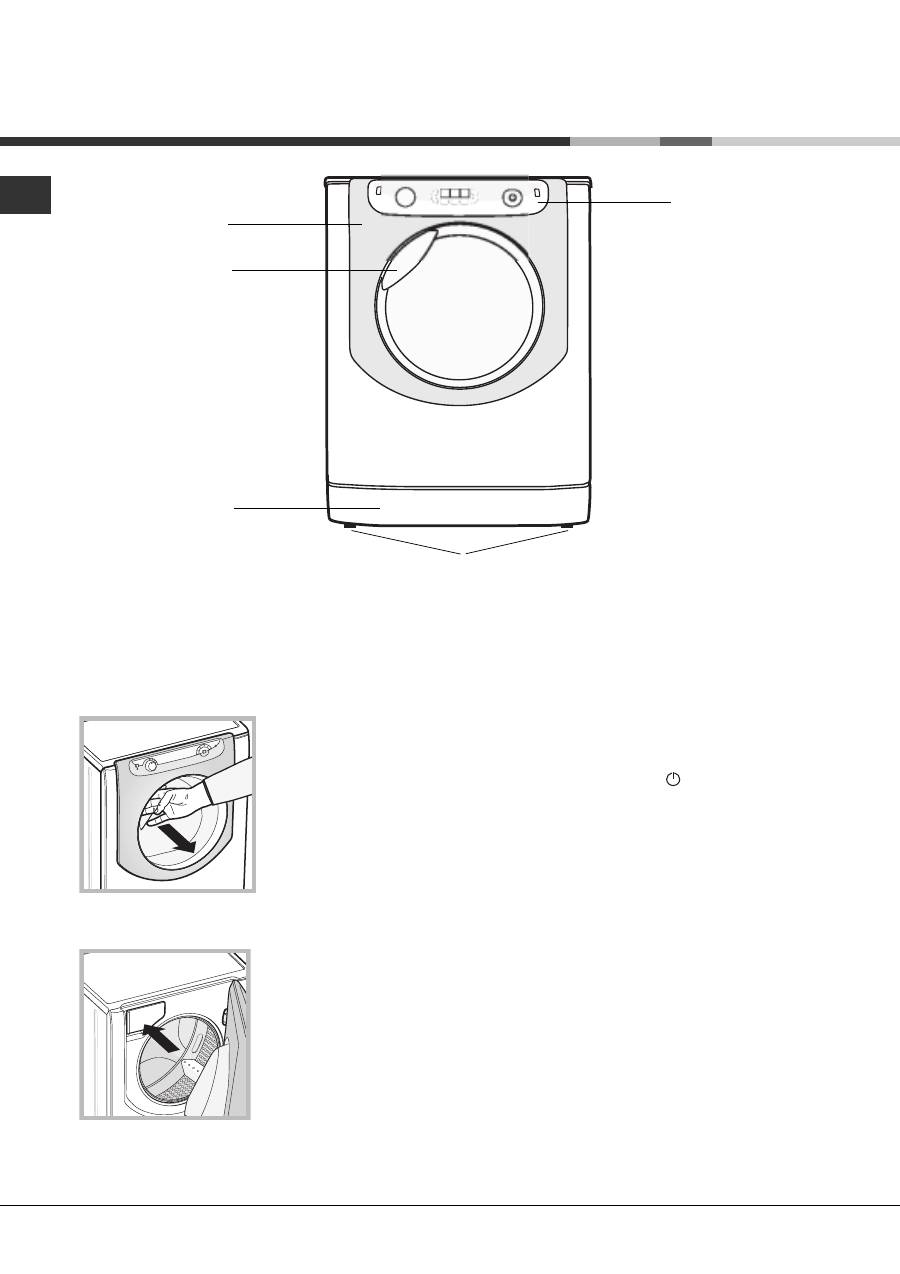
20
I
Descrizione della macchina
PORTA OBLO
Per aprire la porta oblò
utilizzare sempre lapposita
maniglia
(vedi figura).
CASSETTO DETERSIVI
Il cassetto detersivi si
trova allinterno della
macchina e vi si accede
aprendo la porta.
Per lutilizzo vedi il capitolo
Auto Dose System
.
Per il dosaggio dei detersi-
vi vedi il capitolo
Detersivi
e biancheria
.
Nota:
attaccare sul
cassetto detersivi ladesivo con le descrizioni dei
programmi e opzioni. Ladesivo si trova nella busta
contenente questo libretto.
PANNELLO
COMANDI
PORTA OBLÒ
MANIGLIA
PORTA
OBLÒ
ZOCCOLO
PIEDINI REGOLABILI
Modalità di stand by
Questa lavatrice, in conformità alle nuove normative
legate al risparmio energetico, è dotata di un sistema
di autospegnimento (stand by) che entra in funzione
dopo circa 30 minuti nel caso di non utilizzo. Premere
brevemente il tasto ON-OFF e attendere che la
macchina si riattivi.
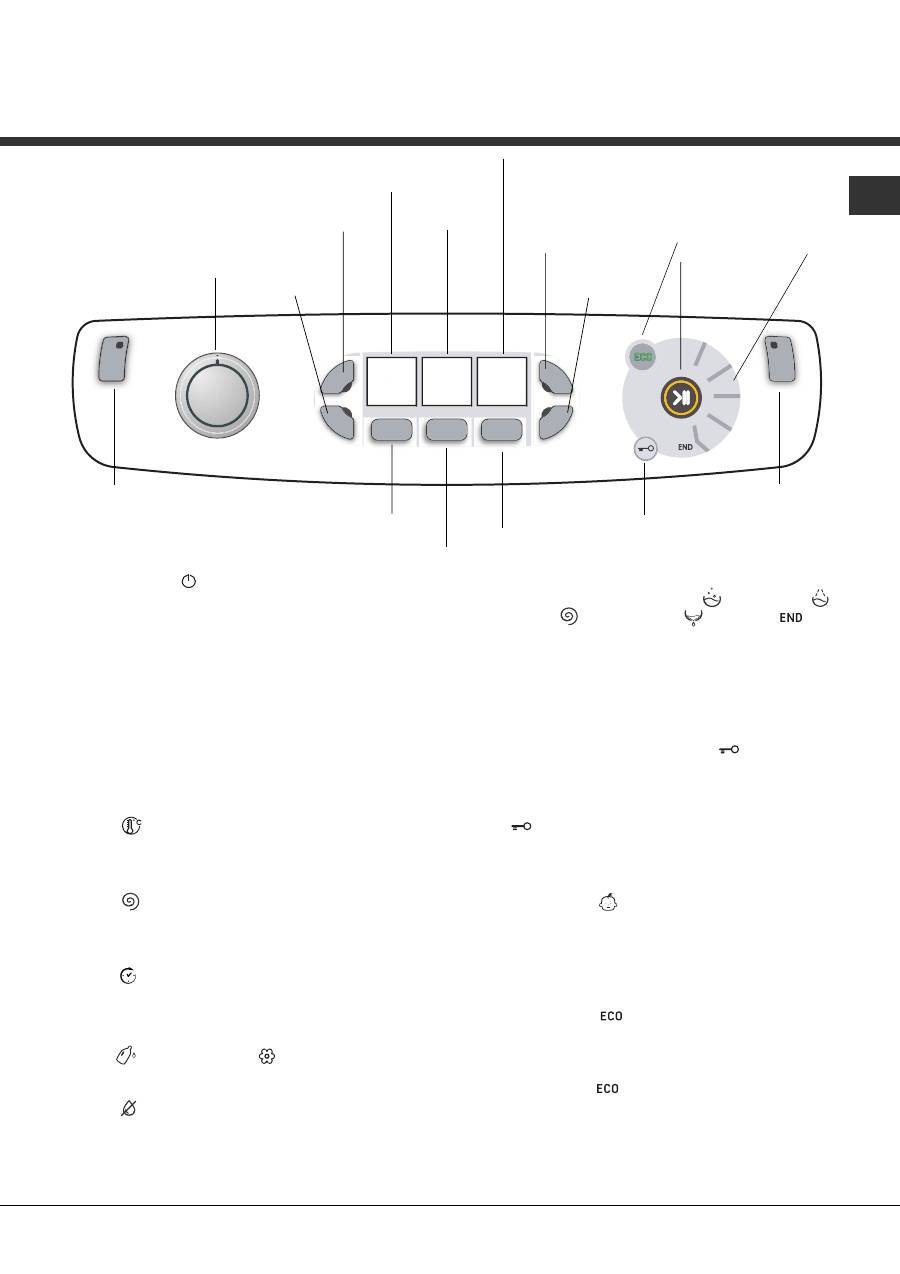
21
I
Pulsante con spia
ON/OFF:
premere brevemente il
pulsante per accendere o spegnere la macchina. La
spia verde indica che la macchina è accesa. Per
spegnere la lavabiancheria durante il lavaggio è
necessario tenere premuto il pulsante più a lungo,
circa 3 sec.; una pressione breve o accidentale non
permetterà lo spegnimento della macchina.
Lo spegnimento della macchina durante un lavaggio in
corso annulla il lavaggio stesso.
Manopola
PROGRAMMI:
può essere ruotata in
entrambe le direzioni. Per impostare il programma più
adatto vedi la
Tabella programmi
. Durante il lavaggio
la manopola resta ferma.
Pulsante
TEMPERATURA:
premere per modificare
o escludere la temperatura; il valore scelto viene indicato
dal display soprastante (vedi
Come effettuare un ciclo
di lavaggio
).
Pulsante
CENTRIFUGA:
premere per modificare o
escludere la centrifuga; il valore scelto viene indicato dal
display soprastante (vedi
Come effettuare un ciclo di
lavaggio
).
Pulsante
PARTENZA RITARDATA:
premere per
impostare una partenza ritardata del programma prescelto;
il valore del ritardo impostato viene indicato dal display
soprastante (vedi
Come effettuare un ciclo di lavaggio
).
Pulsanti
DETERGENTE e AMMORBIDENTE:
vedi "Modificare i parametri pre-impostati" nel capitolo
"Auto Dose System" .
Pulsante
DILUIZIONE DETERGENTE:
vedi
"Riempire i Serbatoi" nel capitolo "Auto Dose System".
Pulsante con Spia
OPZIONE:
premere per selezionare
lopzione disponibile. La spia relativa allopzione rimarrà
accesa (vedi
Come effettuare un ciclo di lavaggio
).
Icone
FASI DI LAVAGGIO:
si illuminano ad indicare
l'avanzamento del ciclo (Lavaggio
- Risciacquo
- Centrifuga - Scarico finale
). La scritta
si
illumina quando il ciclo è terminato.
Pulsante con spia
AVVIO/PAUSA:
quando la spia
verde lampeggia lentamente, premere il pulsante per
avviare un lavaggio. A ciclo avviato la spia diventa
fissa. Per mettere in pausa il lavaggio, premere
nuovamente il pulsante; la spia lampeggerà con colore
arancione. Se la spia Blocco porta
è spenta, si
potrà aprire la porta oblò. Per far ripartire il lavaggio
dal punto in cui è stato interrotto, premere
nuovamente il pulsante.
Spia
BLOCCO PORTA:
indica che la porta oblò è
bloccata. Per aprire la porta è necessario mettere il
ciclo in pausa (vedi
Come effettuare un ciclo di
lavaggio
).
Pulsante con spia
BLOCCO TASTI:
per attivare o
disattivare il blocco del pannello comandi, tenere
premuto il pulsante per circa 2 secondi. La spia accesa
indica che il pannello comandi è bloccato. In questo
modo si impediscono modifiche accidentali dei
programmi, soprattutto se in casa ci sono dei bambini.
Spia
ECO:
licona
si accenderà quando,
modificando i parametri di lavaggio, si otterrà un
risparmio di energia di almeno il 10%.
Inoltre prima che la macchina entri nella modalità di
Stand by licona
si accenderà per pochi secondi;
a macchina spenta il recupero energetico stimato sarà
dell80% circa.
Pannello comandi
Pulsante
TEMPERATURA
Manopola
PROGRAMMI
Spia
BLOCCO
PORTA
Pulsante con spia
AVVIO/
PAUSA
Icone
FASI DI
LAVAGGIO
Pulsante
CENTRIFUGA
Pulsante
PARTENZA
RITARDATA
Pulsante con spia
BLOCCO
TASTI
Pulsante con spia
ON/OFF
Spia
ECO
Pulsante e Spia
OPZIONE
Display
TEMPERATURA/
DETERGENTE
Display
CENTRIFUGA
Display
PARTENZA RITARDATA/
AMMORBIDENTE/DURATA
CICLO
Pulsante
DETERGENTE
Pulsante
DILUIZIONE
DETERGENTE
Pulsante
AMMORBIDENTE
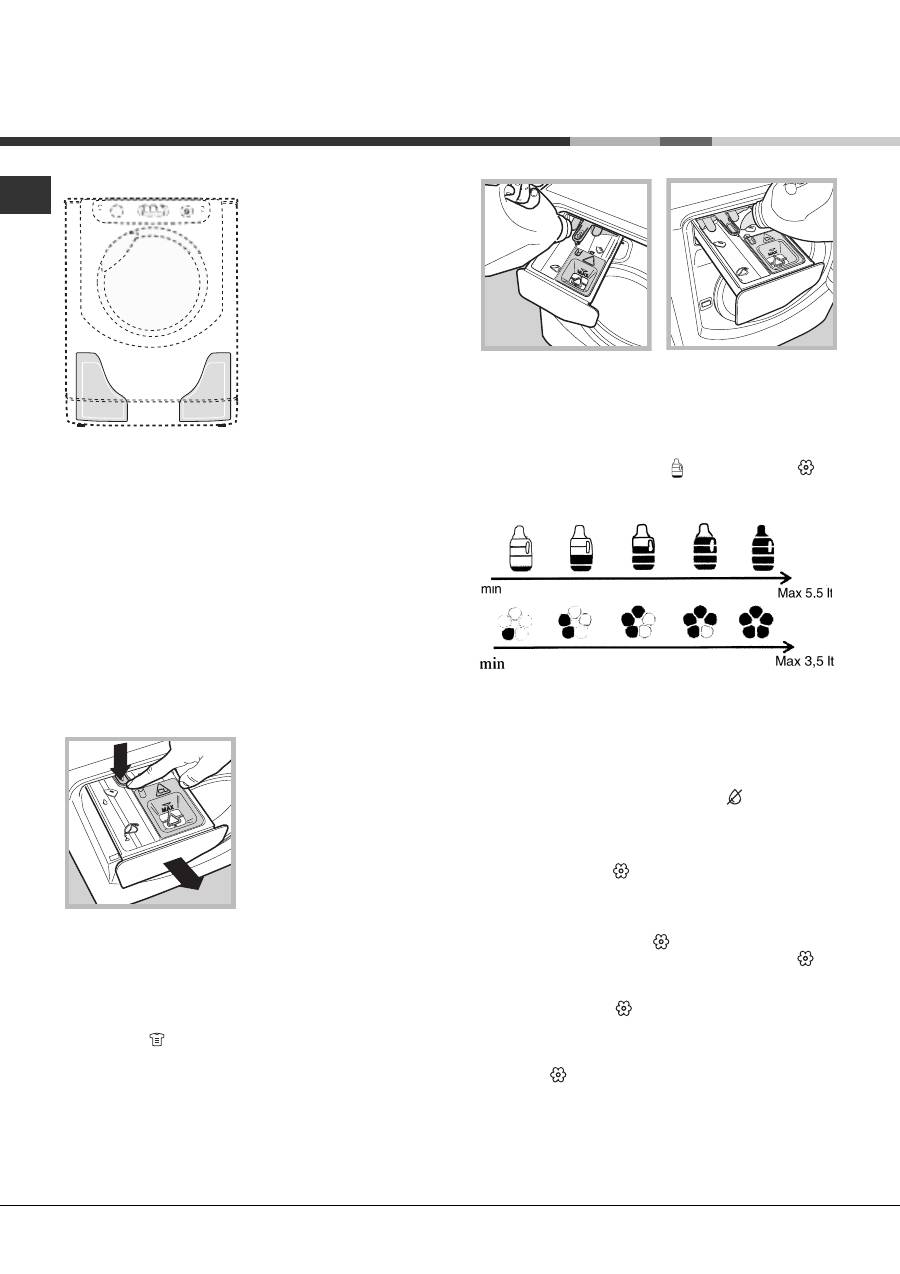
22
I
Auto Dose System
Introduzione
Questa lavabiancheria è
provvista di due serbatoi: uno
per il detersivo liquido
(concentrato o diluito) della
capacità di circa 5,5 lt e
l'altro per l'ammorbidente
liquido (concentrato o diluito)
della capacità di circa 3,5 lt
(vedi figura).
Controlla sul contenitore del
detersivo/ammorbidente se è
diluito o concentrato.
Il sistema di dosaggio
automatico preleva dai serbatoi
la quantità ideale di detersivo e ammorbidente per ogni tipo
di carico e nel momento più indicato, garantendo risultati di
lavaggio ottimali e senza sprechi. E' possibile modificare la
quantità di detersivo e di ammorbidente manualmente
agendo sui pulsanti DETERGENTE e AMMORBIDENTE
(vedi
"Modificare i parametri pre-impostati").
Se si desidera è
possibile utilizzare la lavabiancheria nel modo tradizionale,
caricando il detersivo nel cassetto; la macchina ne rileva
automaticamente la presenza e non utilizza i serbatoi.
Cassetto detersivi
Modalità Tradizionale.
Estrarre il cassetto detersivi fino al primo fermo
per
caricare il detersivo (liquido o in polvere), la candeggina o
altri additivi (es. sbiancanti) e il detersivo per il
prelavaggio per l'uso in modo tradizionale
(vedi "Utilizzo
tradizionale").
Modalità Auto Dose.
Per riempire i serbatoi di
detergente e ammorbidente
aprire il cassetto detersivi
fino al primo fermo, quindi
premere la levetta (A) ed
estrarlo fino al secondo
fermo
accertandosi che
arrivi a battuta
.
Una volta riempiti i serbatoi
(vedi "Riempire i serbatoi")
, la
macchina avrà autonomia di
circa 40 cicli per il detergente.
Primo utilizzo
Accendere la lavabiancheria premendo il pulsante ON/OFF.
Il primo lavaggio deve essere effettuato senza biancheria
ma con detersivo versato direttamente nel cassetto
detergenti
(vedi modalità Tradizionale)
impostando il
programma (Cotone 90°) senza prelavaggio e senza
caricare i serbatoi.
Riempire i serbatoi:
Aprire il cassetto dei detersivi in modalità
Auto Dose
(vedi Cassetto Detersivi).
Versare lentamente il detersivo (
B
) e lammorbidente (
C
)
in modo da riempire completamente i serbatoi
(vedi
figure)
.
Per non superare la quantità massima, un segnale
acustico (beep) con l'intensità crescente avviserà del
livello raggiunto fino al completo riempimento del
serbatoio indicato da 3 beep lunghi.
Iniziare subito il lavaggio dopo aver riempito i serbatoi
per garantire la pulizia del cassetto.
Sul display le rispettive icone (per detersivo) e
(per ammorbidente) si illumineranno gradualmente per
indicare la quantità raggiunta.
Il tempo di caricamento dipende dalla densità del
prodotto. Con prodotti molto densi i tempi di
caricamento saranno più lunghi.
Chiudere il cassetto detersivi solo quando le vaschette
si saranno completamente svuotate.
Selezionare la densità del detersivo versato (concentrato
o diluito) premendo l'apposito pulsante .
La macchina memorizzerà la scelta.
Non effettuando la selezione, il prelievo del detersivo
sarà impostato su "
diluito
".
Utilizzare il pulsante per impostare la quantità di
ammorbidente che verrà prelevato automaticamente
dalla macchina:
1)
Se l'ammorbidente è concentrato, si consiglia di
selezionare il primo livello ( con 1 barretta) ed
aumentare eventualmente di una sola posizione (
con 2 barrette) per incrementarne il prelievo.
2)
Se l'ammorbidente è diluito, si consiglia di
impostare il 3 livello ( con 3 barrette) e aumentare/
diminuire da qui la quantità di ammorbidente da
prelevare.
3)
Per escludere l'utilizzo dell'ammorbidente premere
il pulsante fino a far scomparire le barrette
(vedi
anche Modificare i parametri pre-impostati).
Segnalazione per riempimenti successivi:
Quando il livello residuo del detersivo/ammorbidente
scenderà sotto la quantità necessaria, alla fine del
ciclo, sul display lampeggerà lentamente il primo
A
B
C
(*)
con carico medio di 4 kg, programma Cotone 40°C, durezza dell'acqua
"media" e livello di sporco impostato su 3.
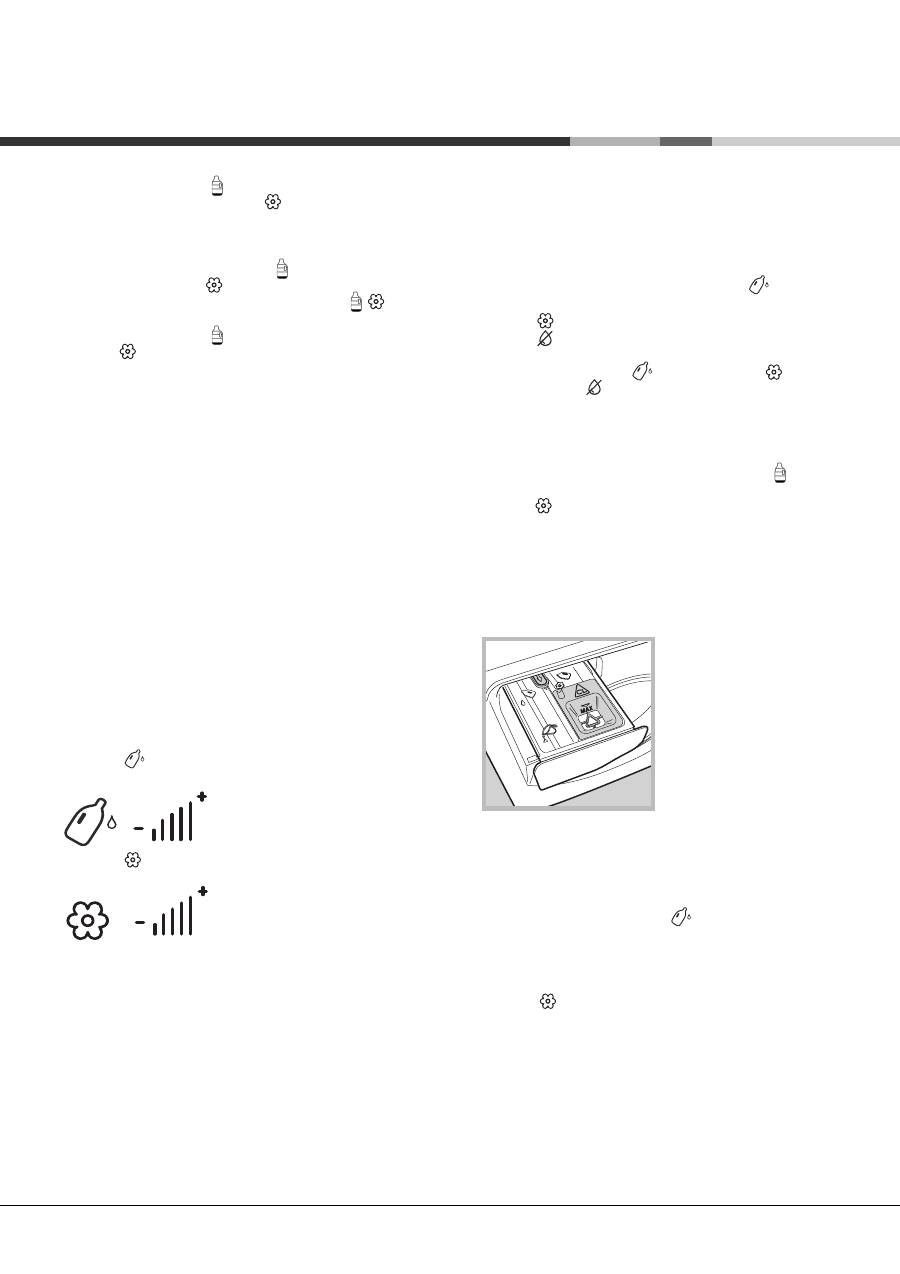
23
segmento del simbolo per il detersivo, oppure il petalo
in basso a sinistra del simbolo per lammorbidente.
Quando il detersivo/ammorbidente sarà esaurito, il vuoto
del serbatoio detersivo o del serbatoio ammorbidente
verrà rispettivamente visualizzato con il lampeggio veloce
del primo segmento del simbolo o del petalo in basso
a sinistra del simbolo .
Durante il ciclo, con serbatoi vuoti, i simboli
scompariranno; invece a fine ciclo ed in pausa il primo
segmento del simbolo e il petalo in basso a sinistra del
simbolo lampeggeranno velocemente. Se non
vengono caricati i serbatoi, i lavaggi successivi in modalità
Auto Dose
saranno effettuati senza prelevare il detersivo
.
Si consiglia di ricaricare il detergente e l'ammorbidente
SOLO
dopo l'indicazione della macchina
.
Non mescolare MAI due detersivi differenti; effettuare
sempre la pulizia del serbatoio prima di inserirne uno nuovo
(vedi Pulizia impostata dall'utente).
Utilizzo Auto Dose System
Se i serbatoi sono stati riempiti con detersivo ed ammor-
bidente procedere allutilizzo della macchina
(
vedi Come
effettuare un ciclo di lavaggio).
Il detersivo per il prelavaggio in
polvere
e gli
additivi in
polvere
posso essere usati solo in modalità tradizionale
o in modalità Auto Dose System inserendo gli additivi
direttamente nel cestello, preferibilmente con lausilio
della pallina.
Modificare i parametri pre-impostati:
La macchina preleva automaticamente la quantità di
detersivo in base al programma scelto, la quantità del
carico inserito e la durezza dell'acqua. Tuttavia, si puo'
modificare la quantità del detersivo/ammorbidente.
Pulsante
: premere per aumentare, diminuire e
escludere il prelievo del detergente.
Pulsante : premere per aumentare, diminuire e
escludere lil prelievo dell'ammorbidente.
Il livello di detergente /ammorbidente suggerito dalla
macchina è indicato con 3 barrette.
I livelli minori di 3 barrette indicano meno detersivo/
ammorbidente rispetto al livello suggerito dalla
macchina, mentre i livelli superiori di 3 indicano
l'aumento della quantità del detersivo/ammorbidente.
Pulizia serbatoi:
Sono previsti cicli di pulizia automatica dei serbatoi,
oppure su richiesta dell'utente.
Pulizia automatica:
La lavabiancheria effettua un ciclo di pulizia automatico
durante i risciacqui, quando la quantità di detersivo
residua è insufficiente ad un successivo ciclo di lavaggio.
Pulizia impostata dall'utente:
Effettuare il ciclo di pulizia (con il cestello vuoto) se si
vuole caricare un prodotto differente da quello
precedentemente utilizzato o se i serbatoi sono stati
riempiti in modo errato (l'ammorbidente è stato versato
nello scompartimento del detergente o viceversa). 4.
Tenere premuto per circa 8 sec. il pulsante
per
l'attivazione della pulizia del serbatoio del detersivo, il
pulsante per quello dell'ammorbidente oppure il
pulsante per entrambi i serbatoi. Dopo i "beep" con
l'intensità crescente seguito da 2 "beep" lunghi e
l'animazione delle icone
per il detergente, per
l'ammorbidente, per entrambi i serbatoi, inizierà il
ciclo di pulizia per il contenitore selezionato. Il ciclo di
pulizia dura circa
40
se i serbatoi sono inizialmente
vuoti, in caso contrario la durata del ciclo sarà
maggiore.
Durante il ciclo pulizia dei serbatoi, simbolo si
riempie ripetutamente dal basso verso lalto e il
simbolo si riempie ripetutamente petalo dopo
petalo.
Utilizzo tradizionale
Estrarre il cassetto detersivi fino al primo fermo
(vedi
figura)
, versare direttamente nel cassetto il detersivo e
altri additivi (es. candeggina) necessari per un solo
lavaggio.
1.
vaschetta per il
prelavaggio
: usare
esclusi-
vamente
detersivo in
polvere.
2.
vaschetta per il lavaggio
:
usare detersivo in polvere o
liquido. In questultimo caso
si raccomanda di versarlo
immediatamente prima
dellavvio della
lavabiancheria e senza
effetture il prelavaggio.
3.
Non utilizzare questa vaschetta.
Il detersivo in pastiglie o lapposita pallina devono
essere inseriti direttamente allinterno del cestello. In
questo caso escludere la modalità Auto Dose
System (premere il pulsante
fino a far scomparire
le relative barrette verticali su display).
Non versare l'ammorbidente perché verrà prelevato in
automatico nella quantità richiesta per ogni lavaggio.
Per escludere il prelievo dellammorbidente premere il
pulsante fino a far scomparire le barrette verticali
su display.
Per capi in lana e seta si consiglia di utilizzare il
detergente dedicato versandolo direttamente nel
cassetto detersivi (vaschetta 2).
Effettuare il lavaggio:
Scegliere il programma e le opzioni compatibili in base
alle necessità e tipo di carico.
3
1
2
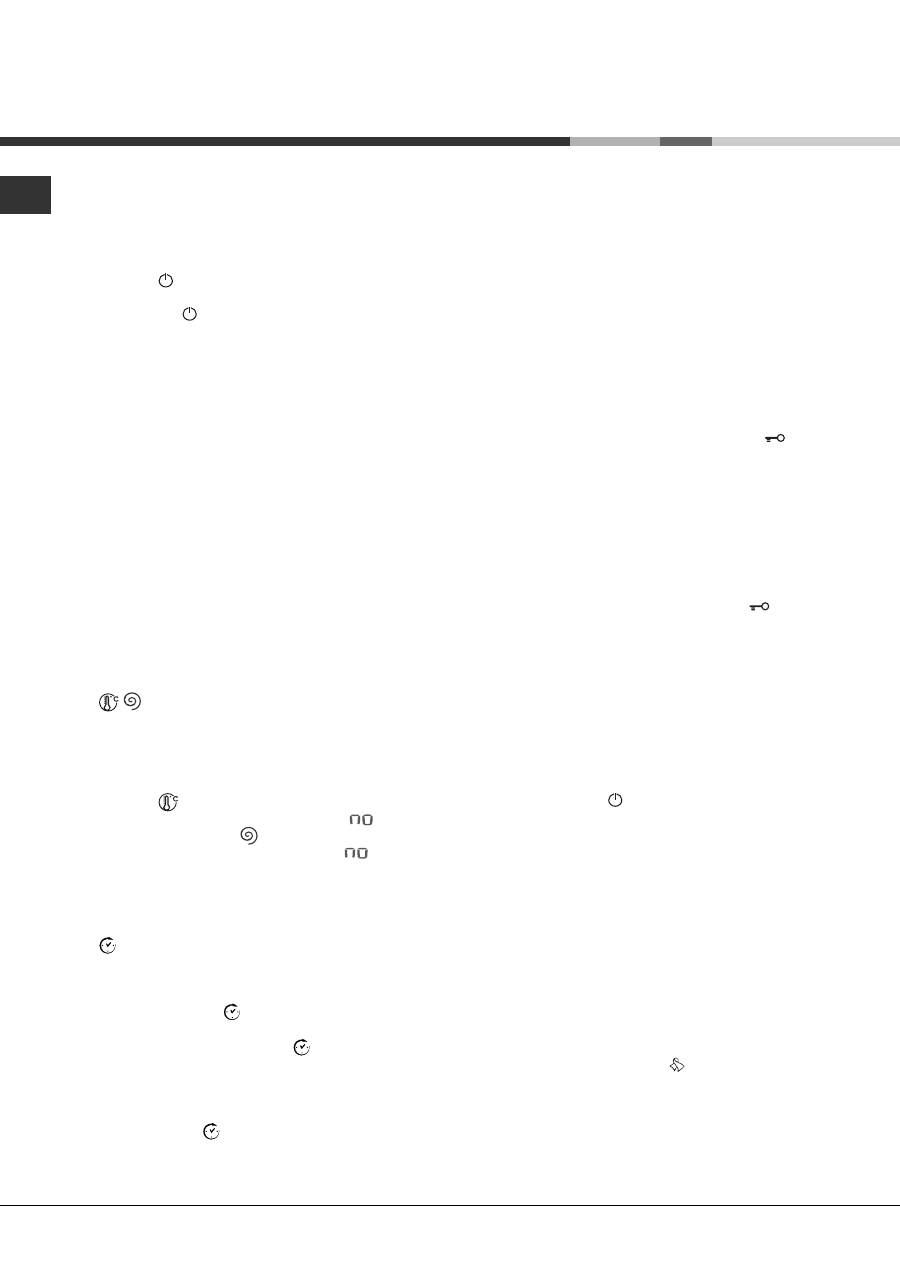
24
I
Come effettuare un ciclo di
lavaggio
NOTA:
la prima volta che si utilizza la lavabiancheria,
effettuare un ciclo di lavaggio senza biancheria ma
con detersivo impostando il programma cotone 90°
senza prelavaggio.
1.
ACCENDERE LA MACCHINA.
Premere il
pulsante . Tutte le spie si accenderanno per 1
secondo dopo il quale rimarrà accesa fissa la spia
del pulsante , la spia AVVIO/PAUSA lampeggerà
lentamente.
2.
CARICARE LA BIANCHERIA.
Aprire la porta
oblò. Caricare la biancheria facendo attenzione a
non superare la quantità di carico indicata nella
tabella programmi della pagina successiva.
3.
DOSARE IL DETERSIVO.
Per l'utilizzo in modalità
Auto Dose non è necessario dosare il detersivo, la
macchina lo preleva automaticamente in base al
programma selezionato, al tipo di carico e alla
durezza dell'acqua. Per l'utilizzo in modalità
tradizionale
vedi "Utilizzo tradizionale".
4.
CHIUDERE LA PORTA OBLO.
5.
SCEGLIERE IL PROGRAMMA.
Ruotare la
MANOPOLA PROGRAMMI verso destra o verso
sinistra fino a selezionare il programma desiderato;
viene associata una temperatura e una velocità di
centrifuga che possono essere modificati.
6.
PERSONALIZZARE IL CICLO DI LAVAGGIO.
Agire sugli appositi pulsanti del pannello comandi:
Modificare la temperatura e/o la
centrifuga.
La macchina visualizza automaticamente la
temperatura e la centrifuga massime previste per il
programma impostato o le ultime selezionate se
compatibili con il programma scelto. Premendo il
pulsante
si riduce progressivamente la
temperatura sino al lavaggio a freddo (
).
Premendo il pulsante si riduce progressivamente
la centrifuga sino alla sua esclusione (
).
Unulteriore pressione dei pulsanti riporterà i valori a
quelli massimi previsti.
Eccezione: selezionando il programma
Cotone
Bianchi
la temperatura può essere portata sino a 90°.
Impostare la partenza ritardata.
Premere il pulsante relativo fino a raggiungere il
tempo del ritardo desiderato. Durante
limpostazione viene visualizzato il tempo del ritardo
insieme al simbolo che lampeggia;
dopo qualche secondo dalla scelta del ritardo il
display visualizzerà il simbolo fisso e la durata
del ciclo. Premendo il pulsante una volta viene
visualizzato il tempo di ritardo impostato.
Per rimuovere la partenza ritardata premere il
pulsante fino a che sul display compare la scritta
OFF
; il simbolo si spegnerà.
Una volta premuto il pulsante AVVIO/PAUSA il
valore del ritardo potrà essere modificato solo
diminuendolo.
Modificare le caratteristiche del ciclo.
Premere il pulsante OPZIONE per personalizzare il
lavaggio secondo le proprie esigenze.
Premere il pulsante per attivare lopzione; si
accenderà la spia relativa.
Premere nuovamente il pulsante per disattivare
lopzione; la spia si spegnerà.
Se lopzione selezionata non è compatibile con il
programma impostato, lincompatibilità verrà
segnalata con il lampeggio della spia ed un segnale
acustico (3 beep) e lopzione non verrà attivata.
7.
AVVIARE IL PROGRAMMA.
Premere il tasto
AVVIO/PAUSA. La spia relativa si fisserà e la porta
oblò si bloccherà (spia BLOCCO PORTA
accesa). Le icone relative alle fasi di lavaggio si
illumineranno durante il ciclo ad indicare la fase in
corso.
Per cambiare un programma mentre un ciclo è in
corso,
mettere la lavabiancheria in pausa
premendo il pulsante AVVIO/PAUSA; selezionare
quindi il ciclo desiderato e premere nuovamente il
pulsante AVVIO/PAUSA. Per aprire la porta mentre
un ciclo è in corso premere il pulsante AVVIO/
PAUSA; se la spia PORTA BLOCCATA
è spenta
sarà possibile aprire la porta. Premere nuovamente
sul pulsante AVVIO/PAUSA per far ripartire il
programma dal punto in cui era stato interrotto.
8.
FINE DEL PROGRAMMA.
Viene indicata dalla
scritta
END
accesa. La porta oblò si potrà aprire
immediatamente. Se la spia AVVIO/PAUSA lampeggia,
premere il pulsante per terminare il ciclo. Aprire la
porta, scaricare la biancheria e spegnere la macchina.
Se si desidera annullare un ciclo già avviato, tenere
premuto il pulsante finché il ciclo non verrà
interrotto e la macchina si spegnerà.
Sacchetto per trapunte, tende e capi delicati
Grazie allo speciale sacchetto fornito in dotazione, la
lavabiancheria Aqualtis ti consente di lavare anche i
capi più preziosi e delicati garantendo loro la massima
protezione. Si raccomanda di utilizzare in ogni caso il
sacchetto per il
lavaggio di trapunte e piumini con
fodera esterna realizzata in materiale sintetico.
Antipiega
Questa funzione interrompe il programma di lavaggio
mantenendo la biancheria in ammollo nell'acqua prima
dello scarico.
Si attiva solo nel programma
(Seta) ed aiuta a
prevenire la formazione di pieghe. Per terminare il ciclo
premere il pulsante AVVIO/PAUSA.
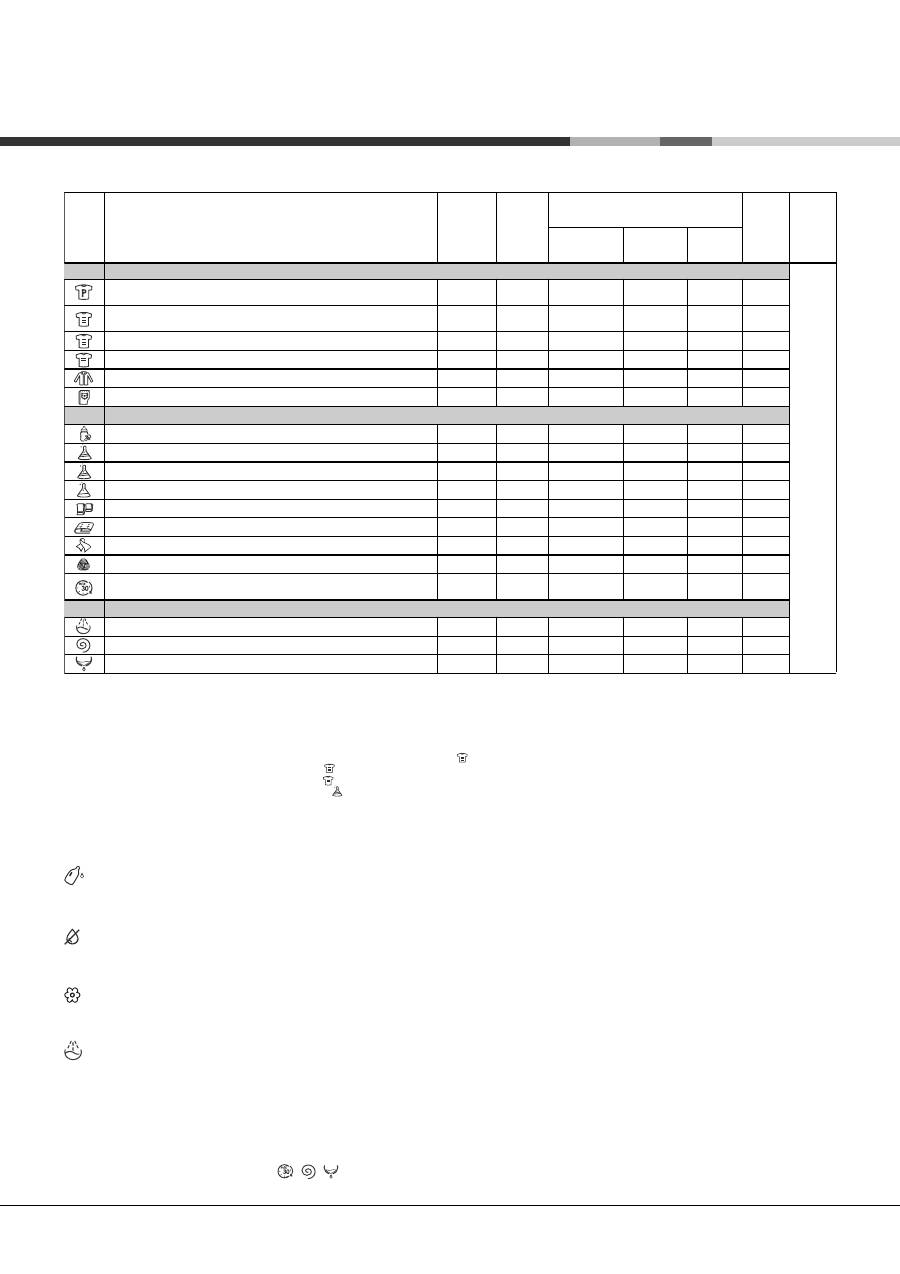
25
Programmi e opzioni
Tabella programmi
Icona Descrizione del Programma
Temp.
max.
(°C)
Velocità
max.
(giri al
minuto)
Detersivi e additivi
Carico
max.
(Kg)
Durata
ciclo
Detersivo
prelavaggio
Detersivo
Lavaggio
Ammor-
bidente
Programmi Cotone
Cotone bianchi
con
prelavaggio
90°
1200
l
l
l
8
Cotone bianchi (1-2):
bianchi e colorati resistenti molto sporchi.
60°
(Max. 90°)
1200
-
l
l
8
Cotone bianchi (2):
bianchi e colorati delicati molto sporchi.
40°
1200
-
l
l
8
Cotone colorati (3)
40°
1200
-
l
l
8
Camicie
40°
600
-
l
l
2
Jeans
40°
800
-
l
l
4
Programmi speciali
Baby:
colori delicati molto sporchi.
40°
800
-
l
l
4
Sintetici resistenti
60°
800
-
l
l
4
Sintetici resistenti (4)
40°
800
-
l
l
4
Sintetici delicati
40°
800
-
l
l
4
Biancheria "7 giorni":
per biancheria da letto e da bagno.
60°
1200
-
l
l
8
Piumini:
per capi imbottiti in piuma d'oca.
30°
1000
-
l
l
3,5
Seta:
per capi in seta, viscosa, lingerie.
30°
0
-
l
l
2
Lana:
per lana, cachemire, ecc.
40°
800
-
l
l
2
Mix 30':
per rinfrescare rapidamente capi poco sporchi (non
indicato per lana, seta e capi da lavare a mano).
30°
800
-
l
l
3,5
Programmi parziali
Risciacquo
-
1200
-
-
l
8
Centrifuga
-
1200
-
-
-
8
Scarico
-
0
-
-
-
8
(*)
E'
possibile
contr
ollar
e
la
durata
dei
pr
ogrammi
di
lavaggio
sul
display
.
(*) Nota:
dopo circa 10 minuti dallo START, la macchina in base al carico effettuato, ricalcolerà e visualizzera il tempo residuo alla fine del programma.
Opzioni
Dosaggio detersivo
Per dosare la quantità di detersivo
(vedi capitolo Auto
Dose System).
Densità detersivo
Per modificare il grado di densità del detersivo
(vedi
capitolo Auto Dose System).
Dosaggio ammorbidente
Per dosare la quantità di ammorbidente
(vedi capitolo Auto
Dose System).
Extra Risciacquo
Selezionando questa opzione si aumenta lefficacia del
risciacquo e si assicura la massima rimozione dei residui
del detersivo. E utile per pelli particolarmente sensibili ai
detersivi. Si consiglia lutilizzo di questa opzione con la
lavabiancheria a pieno carico o con lutilizzo di elevate
dosi di detersivo.
Non è attivabile sui programmi , , .
Per tutti Test Institutes:
1) Programma di controllo secondo la norma 2010/1061: impostare il programma con una temperaura di 60°C e 40°C.
2) Programma cotone lungo: impostare il programma con una temperatura di 40°C.
3) Programma cotone corto: impostare il programma con una temperatura di 40°C.
4) Programma sintetico lungo: impostare il programma con una temperatura di 40°C.
La durata del ciclo indicata sul display o su questo libretto è una stima calcolata in base a condizioni standard. Il tempo effettivo può variare in base a numerosi
fattori quali la temperatura e la pressione dell'acqua in ingresso, la temperatura ambiente, la quantità di detersivo, la quantità ed il tipo di carico, il bilanciamento
del carico, le opzioni aggiuntive selezionate.
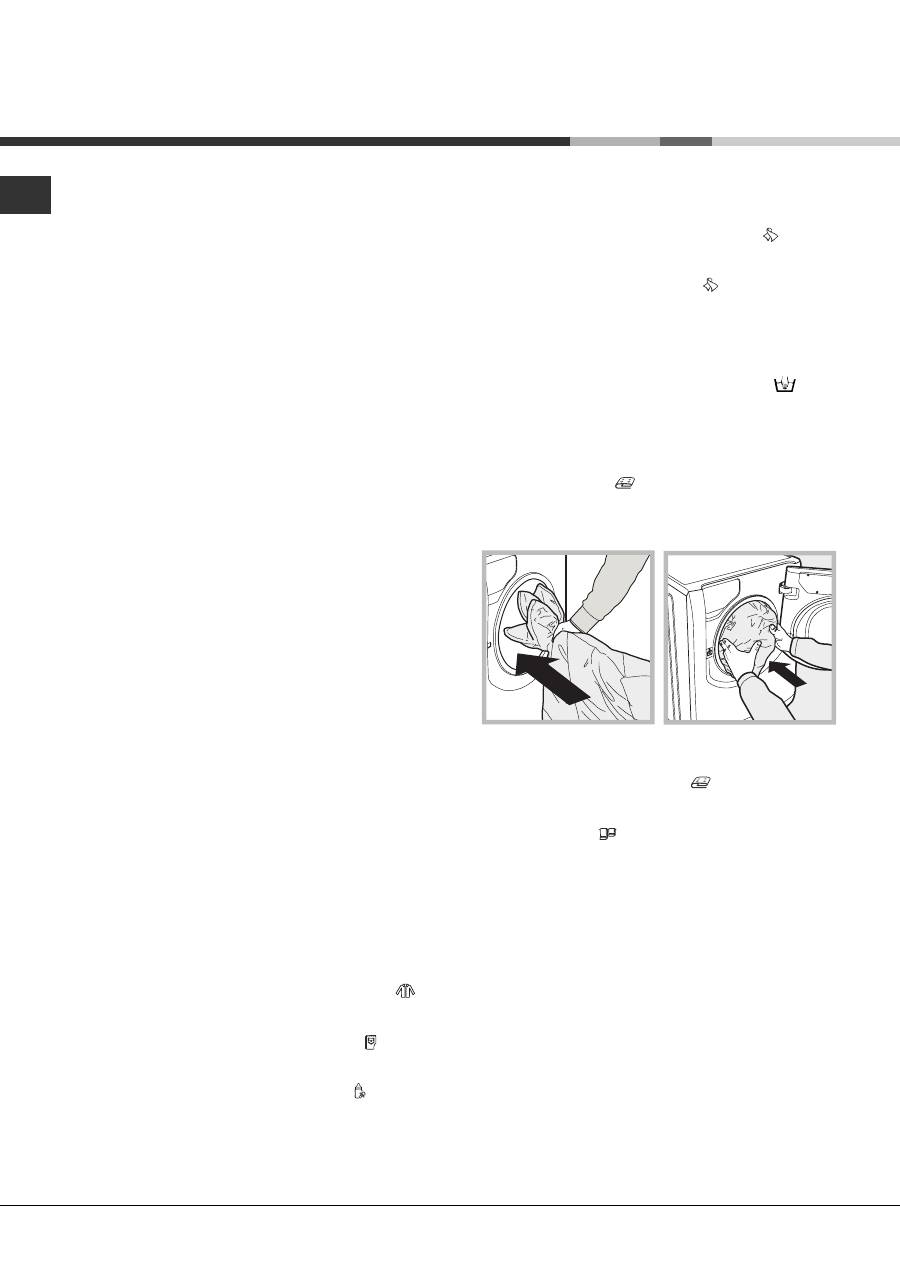
26
I
Detersivi e biancheria
Detersivo
La scelta e la quantità del detersivo dipendono dal tipo
di tessuto (cotone, lana, seta...), dal colore, dalla
temperatura di lavaggio, dal grado di sporco e dalla
durezza dellacqua.
Questa lavabiancheria con il sistema di auto-dosaggio
del detergente e ammorbidente, aiuta ad evitare gli
sprechi e proteggere l'ambiente oltre a garantire le
performance di lavaggio ottimali.
Si consiglia di:
usare il detersivo in polvere se si effettua un
prelavaggio caricandolo in maniera
Tradizionale
.
usare detersivi liquidi per capi delicati in cotone e per
tutti i programmi a bassa temperatura.
per lutilizzo in modalita
Auto Dose System
usare
solo detersivo e ammorbidente liquido.
Non caricare
detergenti superconcentrati, Gel e simili.
usare detersivi liquidi delicati per lana e seta
caricandoli in maniera
Tradizionale.
Non mescolare MAI due detersivi differenti; effettuare
sempre la pulizia del serbatoio prima di inserirne uno
nuovo.
Il detersivo deve essere versato prima dellinizio del
lavaggio nellapposita vaschetta, oppure nel dosatore da
porre direttamente nel cestello. In questo caso non si
può selezionare il ciclo Cotone con prelavaggio.
Non usare detersivi per il lavaggio a mano perché
formano troppa schiuma.
Preparare la biancheria
Aprire bene i capi prima di caricarli.
Suddividere la biancheria secondo il tipo di tessuto
(simbolo sulletichetta del capo) ed il colore facendo
attenzione a separare i capi colorati da quelli bianchi;
Svuotare le tasche e controllare i bottoni;
Non superare i valori indicati nella
Tabella
Programmi
riferiti al peso della biancheria asciutta.
Quanto pesa la biancheria?
1 lenzuolo
400-500 gr.
1 federa
150-200 gr.
1 tovaglia
400-500 gr.
1 accappatoio
900-1200 gr.
1 asciugamano
150-250 gr.
1 jeans
400-500 gr.
1 camicia
150-200 gr.
Consigli di lavaggio
Camicie:
utilizzare lapposito programma Camicie
per lavare camicie di diversi tipi di tessuto e colore per
garantirne la massima cura.
Jeans
: utilizzare lapposito programma Jeans per
tutti i capi in tessuto Denim; rovesciare i capi prima del
lavaggio ed utilizzare un detersivo liquido.
Baby:
utilizzare lapposito programma Baby per
asportare lo sporco tipico dei bambini e rimuovere il
detersivo dai panni onde evitare reazioni allergiche alla
pelle delicata dei bambini. Questo ciclo è stato studiato
per ridurre la carica batterica utilizzando una maggior
quantità di acqua e ottimizzando l'effetto di additivi
specifici igenizzanti aggiunti al detersivo.
Al temine del lavaggio la macchina effettuerà delle lente
rotazioni del cestello; per terminare il ciclo premere il
pulsante AVVIO/PAUSA.
Seta:
utilizzare lapposito programma Seta per
lavare tutti i capi in seta. Si consiglia lutilizzo di un
detersivo specifico per capi delicati.
Tende:
utilizzare il programma Seta . Si raccomanda di
piegarle e inserirle nel sacchetto fornito in dotazione.
Lana:
è lunica lavabiancheria ad aver ottenuto il
prestigioso riconoscimento
Woolmark Platinum Care
(M.0508) da parte di The Woolmark Company, che
certifica il lavaggio in lavatrice di tutti i capi in lana, anche
quelli recanti letichetta solo lavaggio a mano
. Con
il programma Lana si possono lavare in lavatrice tutti i
capi in lana con la garanzia delle migliori performance.
Piumini:
per lavare capi con imbottiture in piuma doca
quali piumoni matrimoniali o singoli (non eccedenti i 3,5
kg. di peso), cuscini, giacche a vento utilizzare lapposito
programma Piumini
. Si raccomanda di caricare i
piumini nel cestello ripiegandone i lembi verso linterno
(vedi figure)
e di non superare i
¾
di volume del cestello
stesso.
Trapunte:
per lavare trapunte con fodera sintetica,
utilizzare l'apposito sacchetto fornito in dotazione e
impostare il programma "Piumini"
.
Biancheria da bagno e da letto:
per lavare la biancheria
di tutta la casa in un unico ciclo utilizzare il programma
Biancheria 7 giorni
che ottimizza lutilizzo di
ammorbidente e ti consente di risparmiare tempo ed energia.
Si consiglia lutilizzo di detersivo in polvere.
Macchie ostinate:
è bene trattare le macchie ostinate
con sapone solido prima del lavaggio e di utilizzare il
programma Cotone con prelavaggio.
Sistema bilanciamento del carico
Prima di ogni centrifuga, per evitare vibrazioni eccessive e per
distribuire il carico in modo uniforme, il cestello effettua delle
rotazioni ad una velocità leggermente superiore a quella del
lavaggio. Se al termine di ripetuti tentativi il carico non fosse
ancora correttamente bilanciato la macchina effettua la
centrifuga ad una velocità inferiore a quella prevista. In
presenza di eccessivo sbilanciamento la lavabiancheria
effettua la distribuzione anzichè la centrifuga. Per favorire
una migliore distribuzione del carico e il suo corretto
bilanciamento si consiglia di mescolare capi grandi e
piccoli.
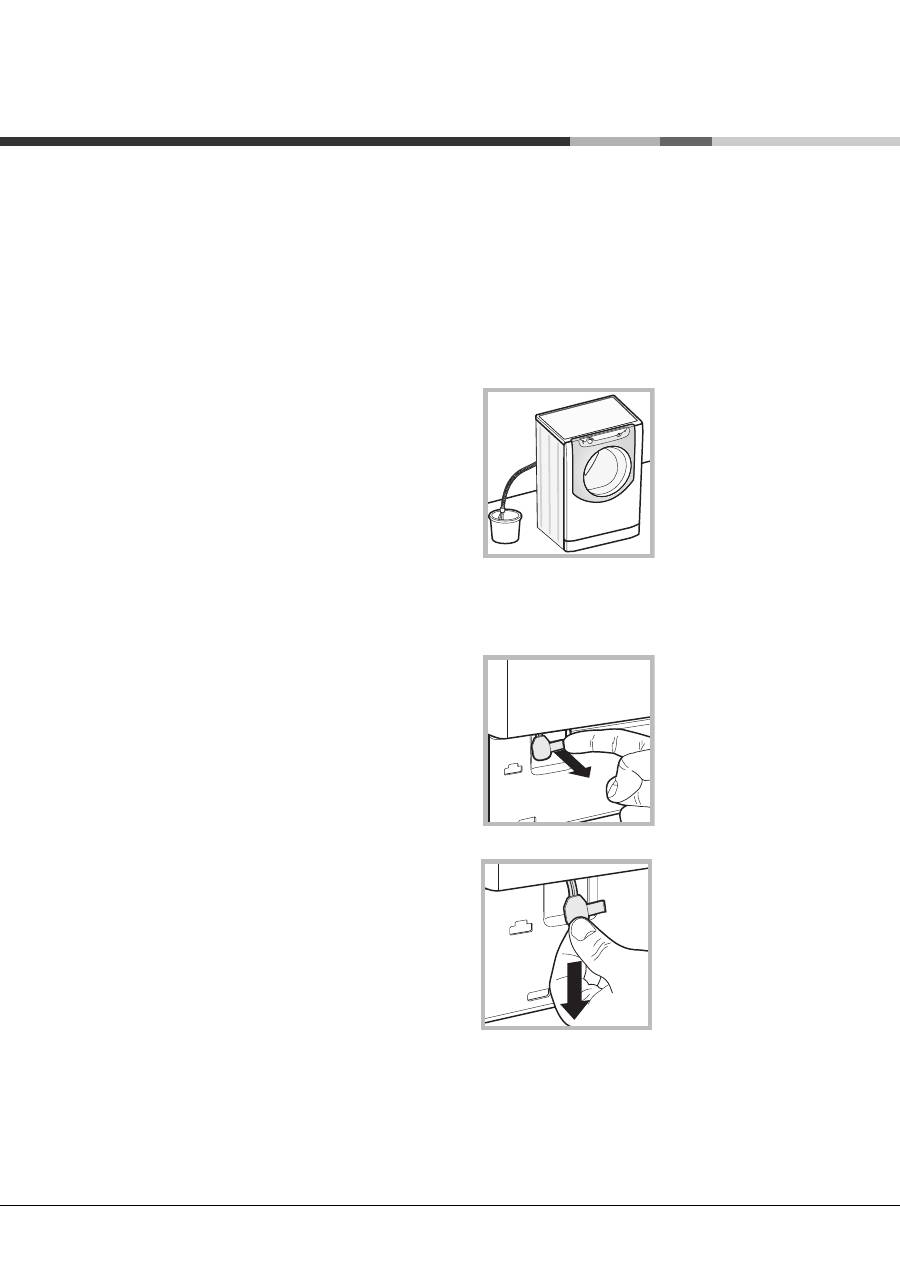
27
Precauzioni e consigli
La macchina è stata progettata e costruita in
conformità alle norme internazionali di sicurezza. Queste
avvertenze sono fornite per ragioni di
sicurezza e devono essere lette attentamente.
Sicurezza generale
Questo apparecchio è stato concepito esclusivamente
per un uso di tipo domestico.
L'apparecchio non deve essere utilizzato da persone
(bambini compresi) con capacità fisiche, sensoriali o
mentali ridotte e con esperienze e conoscenze
insufficienti, a meno che tale utilizzo non avvenga
sotto la supervisione o le istruzioni di una persona
responsabile della loro sicurezza.
I bambini devono essere sorvegliati per garantire che
non giochino con l'apparecchio.
La macchina deve essere usata solo da persone
adulte e secondo le istruzioni riportate in questo
libretto.
Non toccare la macchina a piedi nudi o con le mani o i
piedi bagnati o umidi.
Non staccare la spina dalla presa della corrente
tirando il cavo, bensì afferrando la spina.
Non toccare lacqua di scarico, che può raggiungere
temperature elevate.
Non forzare in nessun caso la porta loblò: potrebbe
danneggiarsi il meccanismo di sicurezza
che
protegge da aperture accidentali.
In caso di guasto, in nessun caso accedere ai
meccanismi interni per tentare una riparazione.
Controllare sempre che i bambini non si avvicinino
alla macchina in funzione.
Se deve essere spostata, lavorare in due o tre persone
con la massima attenzione. Mai da soli perché la
macchina è molto pesante.
Prima di introdurre la biancheria controllare che il
cestello sia vuoto.
Smaltimento
Smaltimento del materiale di imballaggio: attenersi alle
norme locali, così gli imballaggi potranno essere
riutilizzati.
La direttiva Europea 2002/96/CE sui rifiuti di
apparecchiature elettriche ed elettroniche, prevede che
gli elettrodomestici non debbano essere smaltiti nel
normale flusso dei rifiuti solidi urbani. Gli
apparecchi dismessi devono essere raccolti
separatamente per ottimizzare il tasso di recupero e
riciclaggio dei materiali che li compongono ed impedire
potenziali danni per la salute e l'ambiente. Il simbolo del
cestino barrato è riportato su tutti i prodotti per
ricordare gli obblighi di raccolta separata.
Per ulteriori informazioni, sulla corretta dismissione
degli elettrodomestici, i detentori potranno rivolgersi al
servizio pubblico preposto o ai rivenditori.
Apertura manuale della porta oblò
Nel caso non sia possibile aprire la porta oblò a causa
della mancanza di energia elettrica e volete stendere il
bucato, procedere come segue:
1. togliere la spina dalla
presa di corrente
.
2. verificate che il livello
dellacqua allinterno della
macchina sia inferiore
rispetto allapertura delloblò;
in caso contrario togliere
lacqua in eccedenza
attraverso il tubo di scarico
raccogliendola in un secchio
come indicato in
figura
.
3. rimuovere il pannello di copertura sul lato anteriore
della lavabiancheria (
vedi pagina
seguente).
4. utilizzando la linguetta
indicata in figura tirare
verso lesterno fino a
liberare il tirante in plastica
dal fermo; tirarlo
successivamente verso il
basso fino a sentire un
click che indica che la
porta è sbloccata.
5. aprite la porta; nel caso
non sia ancora possibile
ripetete loperazione.
6. rimontare il pannello assicurandosi, prima di
spingerlo verso la macchina, di aver inserito i ganci
nelle apposite asole.
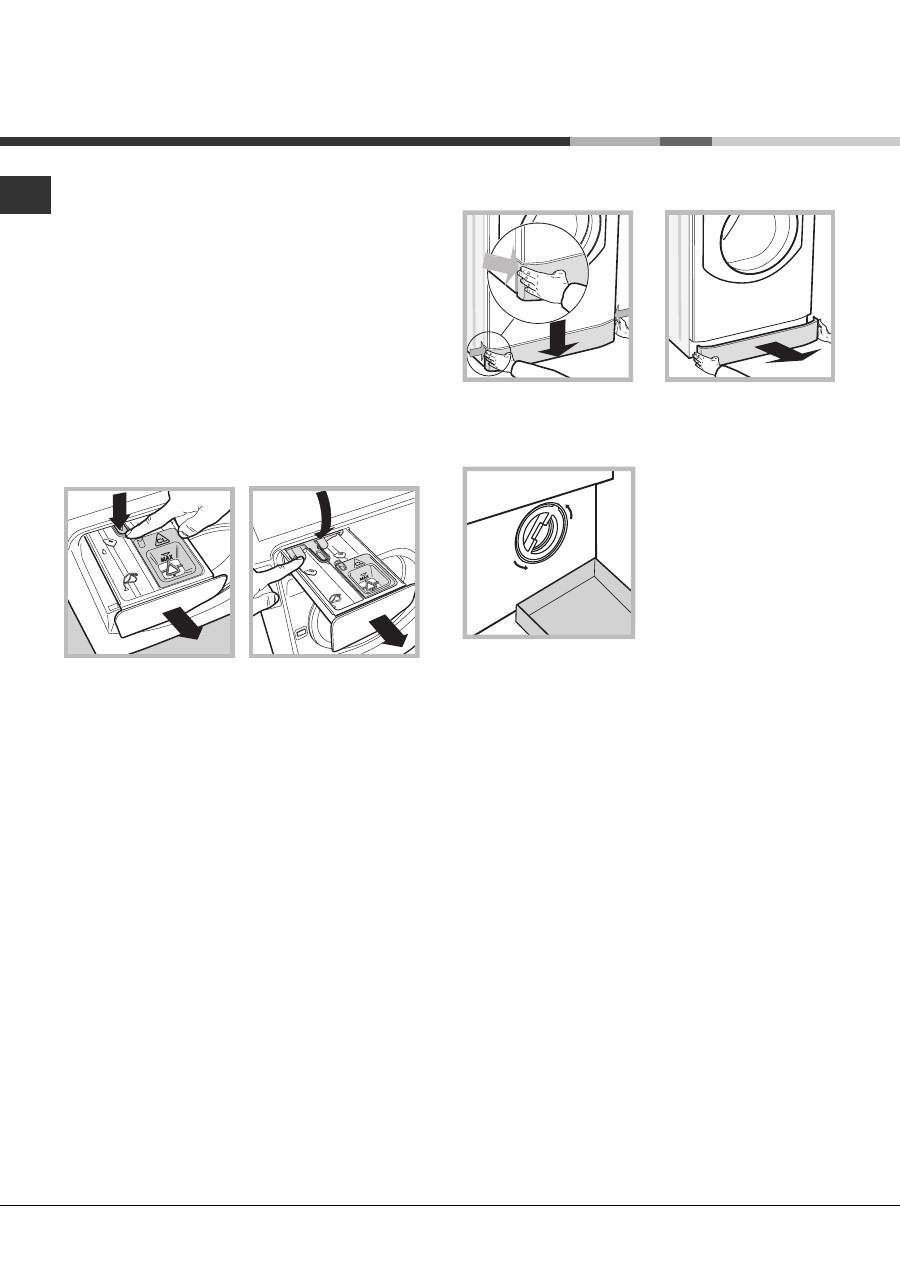
28
I
Manutenzione e cura
Escludere acqua e corrente elettrica
Chiudere il rubinetto dellacqua dopo ogni
lavaggio. Si limita così lusura dellimpianto
idraulico della macchina e si elimina il pericolo di
perdite.
Staccare la spina della corrente quando si pulisce la
macchina e durante i lavori di manutenzione.
Pulire la macchina
La parte esterna e le parti in gomma possono essere
puliti con un panno imbevuto di acqua tiepida e
sapone. Non usare solventi o abrasivi.
Pulire il cassetto dei detersivi
Per estrarre il cassetto, aprirlo fino al primo fermo, poi
premere la leva
A
aprendolo completamente, infine
premere una delle levette
D
e tirarlo verso l'esterno
(vedi figure).
Lavarlo sotto lacqua corrente; questa pulizia va
effettuata frequentemente. Avere cura di rimuovere
anche eventuali residui di detergente dalla sede del
cassetto sulla macchina.
Per rimontarlo occorre tenerlo accostato tutto a
sinistra, facendo attenzione a centrare la guida di
scorrimento per evitare che si incastri.
Curare il cestello
Lasciare sempre socchiusa la porta oblò per evitare
che si formino cattivi odori.
Pulire la pompa
La macchina è dotata di una pompa autopulente che
non ha bisogno di manutenzione. Può però succedere
che piccoli oggetti (monete, bottoni) cadano nella
precamera che protegge la pompa, situata nella parte
inferiore di essa.
Assicurarsi che il ciclo di lavaggio sia terminato e
staccare la spina.
Per accedere alla precamera:
1. rimuovere il pannello di copertura sul lato anteriore
della macchina premendo verso il centro, quindi spingere
verso il basso da entrambe i lati ed estrarlo
(vedi figure);
2. posizionare un contenitore
per raccogliere lacqua che
uscirà (circa 1,5 lt) (
vedi
figura
)
;
3. svitare il coperchio
ruotandolo in senso
antiorario (
vedi
figura
)
;
4. pulire accuratamente linterno;
5. riavvitare il coperchio;
6. rimontare il pannello assicurandosi, prima di spingerlo
verso la macchina, di aver inserito i ganci nelle apposite
asole.
Controllare il tubo di alimentazione
dellacqua
Controllare il tubo di alimentazione almeno una volta
allanno. Se presenta screpolature e fessure va sostituito:
durante i lavaggi le forti pressioni potrebbero provocare
improvvise spaccature.
1
2
A
D

29
I
Anomalie e rimedi
Può accadere che la macchina non funzioni. Prima di telefonare allAssistenza (
vedi Assistenza)
, controllare che
non si tratti di un problema facilmente risolvibile aiutandosi con il seguente elenco.
Anomalie:
La macchina
non si accende.
Il ciclo di lavaggio
non inizia.
La macchina non carica acqua.
La macchina carica e scarica
acqua di continuo.
La macchina non scarica
o non centrifuga.
La macchina vibra
molto durante la centrifuga.
La macchina perde acqua.
Le icone relative alla Fase in
corso lampeggiano velocemente
contemporaneamente alla spia
ON/OFF.
Si forma troppa schiuma.
La porta della macchina rimane
bloccata.
Possibili cause / Soluzione:
La spina non è inserita nella presa della corrente, o non abbastanza
da fare contatto.
In casa non cè corrente.
La porta oblò non è ben chiusa.
Il pulsante AVVIO/PAUSA non è stato premuto.
Il rubinetto dellacqua non è aperto.
Si è impostato un ritardo sullora di avvio (vedi
Come effettuare un ciclo di lavag-
gio
).
Il tubo di alimentazione dellacqua non è collegato al rubinetto.
Il tubo è piegato.
Il rubinetto dellacqua non è aperto.
In casa manca lacqua.
Non cè sufficiente pressione.
Il pulsante AVVIO/PAUSA non è stato premuto.
Il tubo di scarico non è installato fra 65 e 100 cm da terra (
vedi Installazio-
ne).
Lestremità del tubo di scarico è immersa nellacqua (
vedi Installazione).
Se labitazione si trova agli ultimi piani di un edificio, è possibile che si
verifichino fenomeni di sifonaggio, per cui la macchina carica e scarica
acqua di continuo. Per eliminare linconveniente sono disponibili in com-
mercio apposite valvole anti-sifonaggio.
Lo scarico a muro non ha lo sfiato daria.
Il programma non prevede lo scarico: con alcuni programmi occorre
avviarlo manualmente (
vedi Programmi e opzioni).
Il tubo di scarico è piegato (
vedi Installazione).
La conduttura di scarico è ostruita.
Il filtro della pompa di scarico è intasato.
Il cestello, al momento dellinstallazione, non è stato sbloccato
correttamente (
vedi Installazione).
La macchina non è in piano (
vedi Installazione).
La macchina è stretta tra mobili e muro (
vedi Installazione).
Il carico è sbilanciato (
vedi Detersivi e biancheria).
Il tubo di alimentazione dellacqua non è ben avvitato (
vedi Installazione).
Il cassetto dei detersivi è intasato (per pulirlo
vedi Manutenzione e cura)
.
Il tubo di scarico non è fissato bene (
vedi Installazione).
Spegnere la macchina e togliere la spina dalla presa, attendere circa 1
minuto quindi riaccenderla.
Se lanomalia persiste, chiamare lAssistenza.
Il detersivo non è specifico per lavabiancheria (deve esserci la
dicitura per lavatrice, a mano e in lavatrice, o simili).
Il dosaggio è stato eccessivo.
Eseguire la procedura di sblocco manuale
(vedi "Precauzioni e consigli").

30
I
Anomalie:
La macchina non dà buone
performance di lavaggio.
Cosa succede se i serbatoi
sono pieni e li carico?
Cosa succede se uso il cassetto
in modo tradizionale mentre i
serbatoi sono ancora pieni?
I serbatoi sono anche per
detersivo in polvere?
Il detersivo in polvere può
andare nei serbatoi?
Cosa succede se non apro il
cassetto correttamente per il
riempimento dei serbatoi?
Cosa succede se inverto il
detersivo con l'ammorbidente?
Cosa succede se non aspetto
che i serbatoi siano vuoti e
mischio detergenti diversi?
Possibili cause / Soluzione:
I serbatoi non sono stati caricati correttamente (ammorbidente al posto
del detersivo o viceversa).
Si sono mescolati due detersivi/ammorbidenti differenti.
Non mescolare MAI due detersivi/ammorbidenti differenti; effettuare sempre
la pulizia dei serbatoi prima di inserirne altri.
Sistema
Auto Dose System
intasato perché non utilizzato per un
lungo periodo: eseguire una pulizia dei serbatoi
(vedi Pulizia impostata
dal
lutente).
Segnali sonori (Beep) e visivi (icone sul display) indicano che il serbatoio è
pieno. Se si continua a caricare il detersivo/ammorbidente, la quantità in
eccesso andrà nel cestello e sarà lavata via al ciclo successivo.
La macchina riconoscerà automaticamente se è stato caricato detersi-
vo in polvere o detergente liquido nel modo tradizionale e non preleverà
nulla dal serbatoio. L'ammorbidente può essere utilizzato solo in
modalità Auto
dose.
No, il detersivo in polvere può essere utilizzato solo in modo tradiziona-
le.
No, c'è una parete che evita che il detersivo in polvere possa cadere in
uno dei serbatoi anche se il cassetto è aperto in posizione
Auto Dose
System
(completamente aperto).
Se il cassetto non è completamento aperto il detergente o ammorbi-
dente caricato cadrà nel cestello e sarà lavato via al prossimo ciclo.
La macchina laverà con scarsi risultati e sarà necessario svuotare i
serbatoi applicando il ciclo di pulizia manuale.
La macchina laverà normalmente ma si raccomanda di ricaricare solo i
serbatoi dopo il segnale comunicato dalla macchina e non mischiare
detersivi/ammorbidenti diversi.
Nota
: per uscire dal Demo Mode premere contemporanemanete per 3 sec. i due pulsanti ON/OFF e AVVIO/PAUSA .
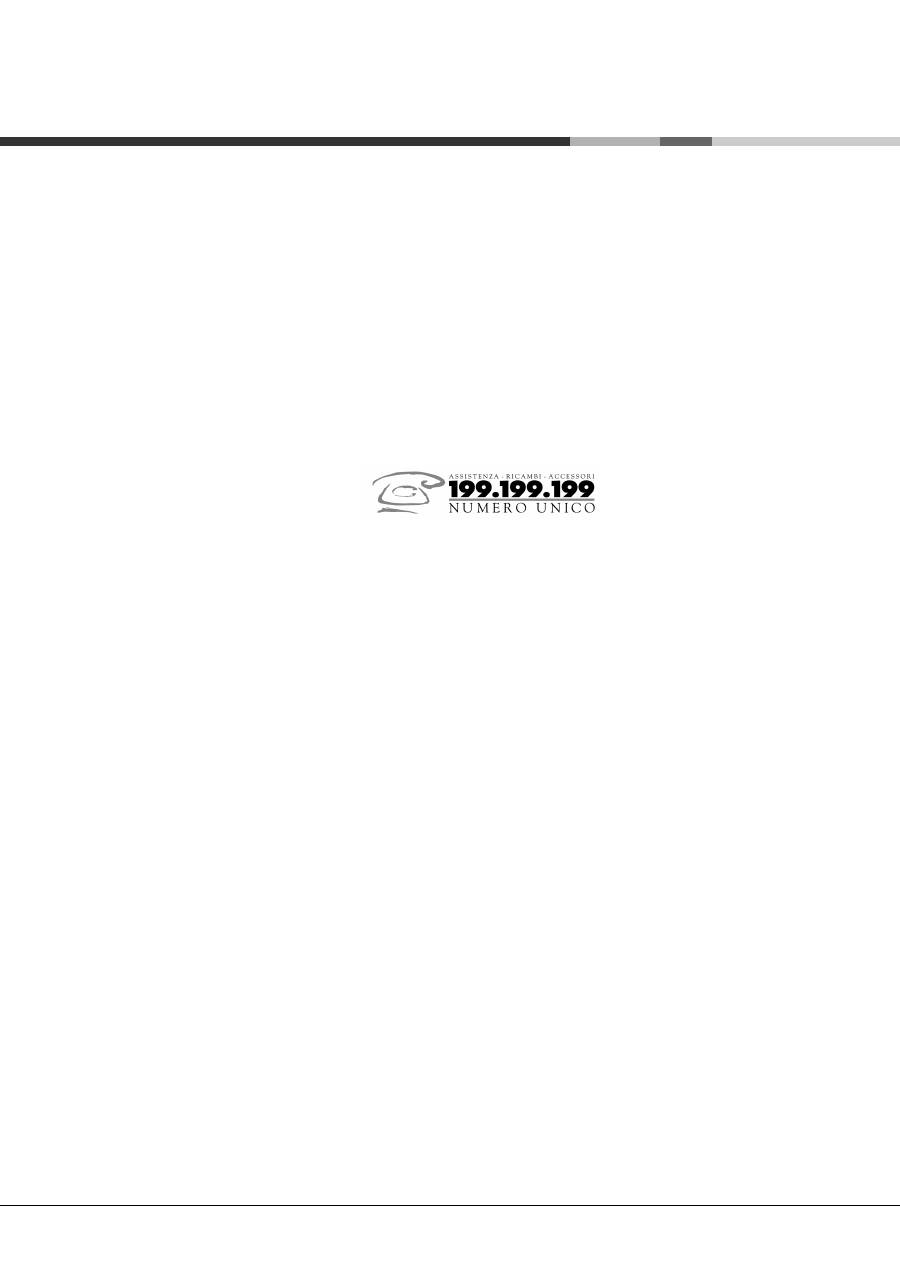
31
Assistenza
Prima di contattare lAssistenza:
Verificare se lanomalia può essere risolta autonomamente (
vedi Anomalie e Rimedi);
Riavviare il programma per controllare se linconveniente è stato ovviato;
In caso negativo, contattare il Servizio Assistenza Tecnico Autorizzato.
In caso di errata installazione o uso non corretto della lavabiancheria lintervento di assistenza sarà a pagamento.
Non ricorrere mai a tecnici non autorizzati.
Comunicare:
il tipo di anomalia;
il modello della macchina (Mod.);
il numero di serie (S/N).
Queste ultime informazioni si trovano sulla targhetta caratteristiche posta sullapparecchio.
Assistenza Attiva 7 giorni su 7
*
In caso di necessità dintervento chiamare il Numero Unico Nazionale 199.199.199*.
Un operatore sarà a completa disposizione per fissare un appuntamento con il Centro Assistenza Tecnico
Autorizzato più vicino al luogo da cui si chiama.
È attivo 7 giorni su 7, sabato e domenica compresi, e non lascia mai inascoltata una richiesta.
* Al costo di 14,25 centesimi di Euro al minuto (iva inclusa) dal Lun. al Ven. dalle 08:00 alle 18:30, il Sab. dalle 08:00 alle 13:00 e di 5,58
centesimi di Euro al minuto (iva inclusa) dal Lun. al Ven. dalle 18:30 alle 08:00, il Sab. dalle 13:00 alle 08:00 e i giorni festivi, per chi
chiama da telefono fisso.
Per chi chiama da radiomobile le tariffe sono legate al piano tariffario delloperatore telefonico utilizzato.
Le suddette tariffe potrebbero essere soggette a variazione da parte delloperatore telefonico; per maggiori informazioni consultare il sito
www.hotpoint-ariston.eu.

32
I

33
CIS
Ðóññêèé
Ñîäåðæàíèå
Óñòàíîâêà, 34-35
Ðàñïàêîâêà è íèâåëèðîâêà
Âîäîïðîâîäíîå è ýëåêòðè÷åñêîå ïîäñîåäèíåíèÿ
Òåõíè÷åñêèå õàðàêòåðèñòèêè
Îïèñàíèå ñòèðàëüíîé ìàøèíû, 36-37
Ïàíåëü óïðàâëåíèÿ
Auto Dose System, 38-39
Ïîðÿäîê âûïîëíåíèÿ öèêëà ñòèðêè, 40
Ïðîãðàììû è äîïîëíèòåëüíûå ôóíêöèè, 41
Òàáëèöà ïðîãðàìì
Äîïîëíèòåëüíûå ôóíêöèè ñòèðêè
Ñòèðàëüíûå âåùåñòâà è òèïû áåëüÿ, 42
Ñòèðàëüíîå âåùåñòâî
Ïîäãîòîâêà áåëüÿ
Ðåêîìåíäàöèè ïî ñòèðêå
Ñèñòåìà áàëàíñèðîâêè áåëüÿ
Ïðåäîñòîðîæíîñòè è ðåêîìåíäàöèè, 43
Îáùèå òðåáîâàíèÿ ïî áåçîïàñíîñòè
Óòèëèçàöèÿ
Îòêðûâàíèå ëþêà âðó÷íóþ
Òåõíè÷åñêîå îáñëóæèâàíèå è óõîä, 44
Îòêëþ÷åíèå âîäû è ýëåêòðè÷åñêîãî òîêà
×èñòêà ìàøèíû
×èñòêà ÿ÷åéêè ñòèðàëüíûõ âåùåñòâ
Óõîä çà áàðàáàíîì
Ïîðÿäîê ÷èñòêè íàñîñà
Ïðîâåðêà âîäîïðîâîäíîãî øëàíãà
Íåèñïðàâíîñòè è ìåòîäû èõ óñòðàíåíèÿ, 45-46
Ñåðâèñíîå îáñëóæèâàíèå, 47
CIS
ÑÒÈÐÀËÜÍÀß ÌÀØÈÍÀ
AQUALTIS
AQLF8F 292 U
Ðóêîâîäñòâî ïî óñòàíîâêå è ýêñïëóàòàöèè
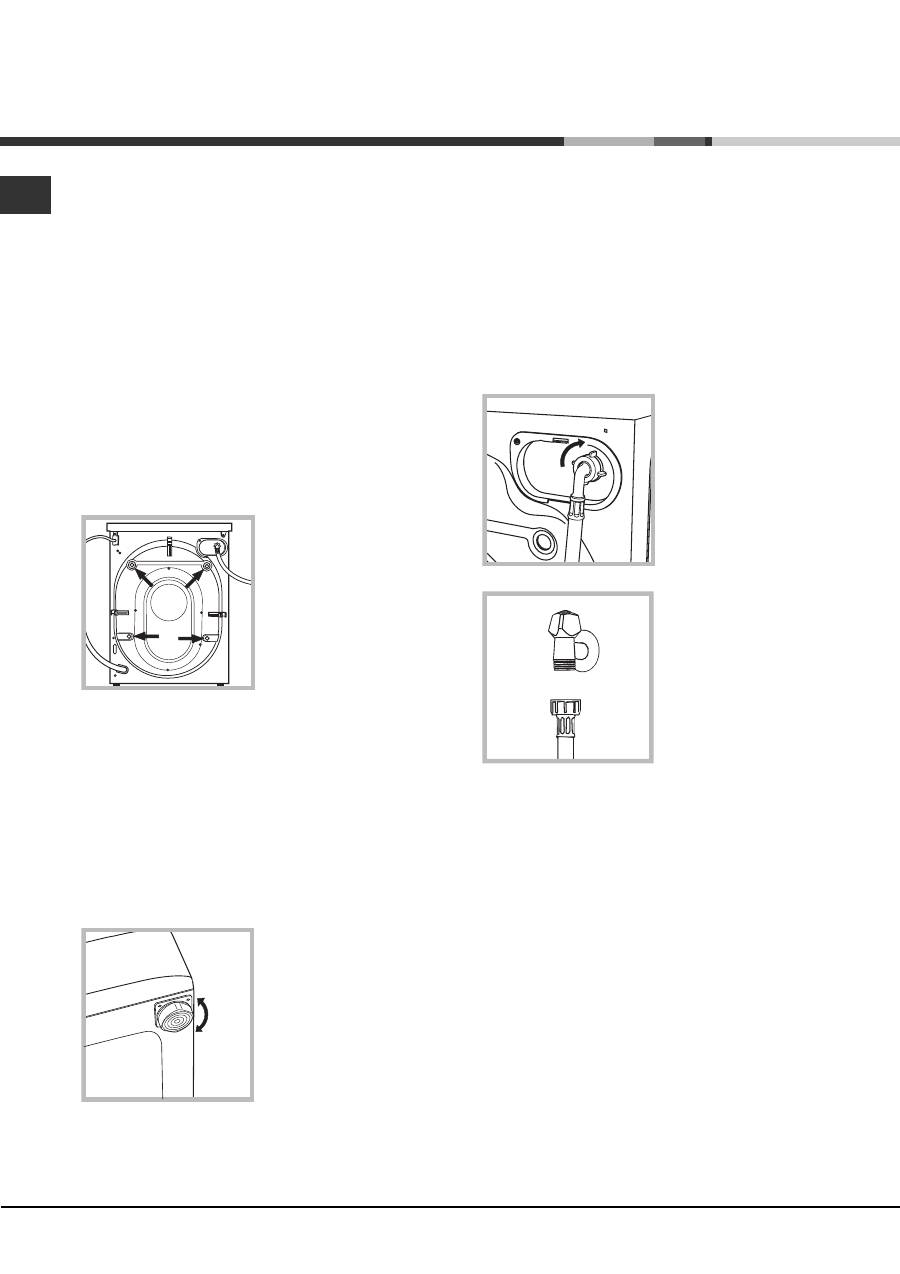
CIS
34
Óñòàíîâêà
! Âàæíî ñîõðàíèòü äàííîå ðóêîâîäñòâî äëÿ åãî
ïîñëåäóþùèõ êîíñóëüòàöèé.  ñëó÷àå ïðîäàæè,
ïåðåäà÷è èëè ïåðååçäà ïðîâåðüòå, ÷òîáû äàííîå
ðóêîâîäñòâî ñîïðîâîæäàëî ñòèðàëüíóþ ìàøèíó.
! Âíèìàòåëüíî ïðî÷èòàéòå èíñòðóêöèè: â íèõ
ñîäåðæàòñÿ âàæíûå ñâåäåíèÿ îá óñòàíîâêå
èçäåëèÿ, åãî ýêñïëóàòàöèè è áåçîïàñíîñòè.
!  ïàêåòå ñ òåõíè÷åñêèì ðóêîâîäñòâîì âû íàéäåòå,
ïîìèìî ãàðàíòèéíîãî òàëëîíà, äåòàëè, íåîáõîäèìûå
äëÿ óñòàíîâêè ìàøèíû.
Ðàñïàêîâêà è íèâåëèðîâêà
Ñíÿòèå óïàêîâêè
1. Ïîñëå ñíÿòèÿ óïàêîâêè ñî ñòèðàëüíîé ìàøèíû
ïðîâåðüòå, ÷òîáû íà íåé íå áûëî ïîâðåæäåíèé,
âûçâàííûõ ïðè ïåðåâîçêå.
 ñëó÷àå îáíàðóæåíèÿ ïîâðåæäåíèé íåìåäëåííî
îáðàòèòåñü ê ïîñòàâùèêó, íå ïîäêëþ÷àÿ ìàøèíó.
2. Ñíèìèòå 4 âèíòà,
ïðåäîõðàíÿþùèå
ìàøèíó â ïðîöåññå
ïåðåâîçêè, è ðàñïîðêè,
ðàñïîëîæåííûå â çàäíåé
÷àñòè ìàøèíû (
ñì.
ñõåìó).
3. Çàêðîéòå îòâåðñòèÿ ðåçèíîâûìè çàãëóøêàìè,
êîòîðûå âû íàéäåòå â ïàêåòå.
4. Ñîõðàíèòå âñå äåòàëè.
 ñëó÷àå ïîñëåäóþùåé
ïåðåâîçêè ñòèðàëüíîé ìàøèíû, îíè äîëæíû áûòü
óñòàíîâëåíû âî èçáåæàíèå åå ïîâðåæäåíèÿ.
! Íå ðàçðåøàéòå äåòÿì èãðàòü ñ óïàêîâî÷íûìè
ìàòåðèàëàìè.
Íèâåëèðîâêà
1. Óñòàíîâèòå ñòèðàëüíóþ ìàøèíó íà ïëîñêîì è
ïðî÷íîì ïîëó, íå ïðèñëîíÿÿ åå ê ñòåíàì èëè ê
ìåáåëè.
2. Âûðîâíÿéòå ìàøèíó
ïðè ïîìîùè
ðåãóëèðóåìûõ íîæåê äî
ïîëíîãî âûðàâíèâàíèÿ
(íàêëîí íå äîëæåí
ïðåâûøàòü 2-õ
ãðàäóñîâ).
! Òùàòåëüíàÿ íèâåëèðîâêà ãàðàíòèðóåò ñòàáèëüíîñòü
è óñòðàíÿåò âèáðàöèè è øóì, â îñîáåííîñòè â
ïðîöåññå îòæèìà.
!  ñëó÷àå óñòàíîâêè ìàøèíû íà êîâåð èëè
êîâðîâîå ïîêðûòèå îòðåãóëèðóéòå íîæêè òàêèì
îáðàçîì, ÷òîáû ïîä ñòèðàëüíîé ìàøèíîé îñòàâàëñÿ
äîñòàòî÷íûé çàçîð äëÿ âåíòèëÿöèè.
Âîäîïðîâîäíîå è ýëåêòðè÷åñêîå
ïîäñîåäèíåíèÿ
Ïîðÿäîê ïîäñîåäèíåíèÿ øëàíãà ïîäà÷è âîäû
!
Ïåðåä ïîäñîåäèíåíèåì âîäîïðîâîäíîãî øëàíãà ê
âîäîïðîâîäó äàéòå ñòå÷ü âîäå äî òåõ ïîð, ïîêà
îíà íå ñòàíåò ïðîçðà÷íîé.
1. Ïîäñîåäèíèòå øëàíã ê
ìàøèíå, ïðèâèíòèâ åãî ê
ñïåöèàëüíîìó êðàíó,
ðàñïîëîæåííîìó â
çàäíåé âåðõíåé ÷àñòè
ñïðàâà
(ñì. ñõåìó).
2. Ïðèêðóòèòå øëàíã
ïîäà÷è ê
âîäîïðîâîäíîìó êðàíó
õîëîäíîé âîäû ñ
ðåçüáîâûì îòâåðñòèåì
3/4 ãàç,
(ñì. ñõåìó)
.
3. Ïðîâåðüòå, ÷òîáû âîäîïðîâîäíûé øëàíã íå áûë
çàëîìëåí èëè ñæàò.
! Âîäîïðîâîäíîå äàâëåíèå â êðàíå äîëæíî áûòü â
ïðåäåëàõ çíà÷åíèé, óêàçàííûõ â òàáëèöå
Òåõíè÷åñêèå äàííûå
(ñì. ñòðàíèöó ðÿäîì).
! Åñëè äëèíà âîäîïðîâîäíîãî øëàíãà áóäåò
íåäîñòàòî÷íîé, ñëåäóåò îáðàòèòüñÿ â
ñïåöèàëèçèðîâàííûé ìàãàçèí èëè ê
óïîëíîìî÷åííîìó ñàíòåõíèêó.
! Íèêîãäà íå èñïîëüçóéòå á/ó èëè ñòàðûå øëàíãè äëÿ
ïîäà÷è âîäû, à òîëüêî ïðèëàãàþùèåñÿ ê ìàøèíå.
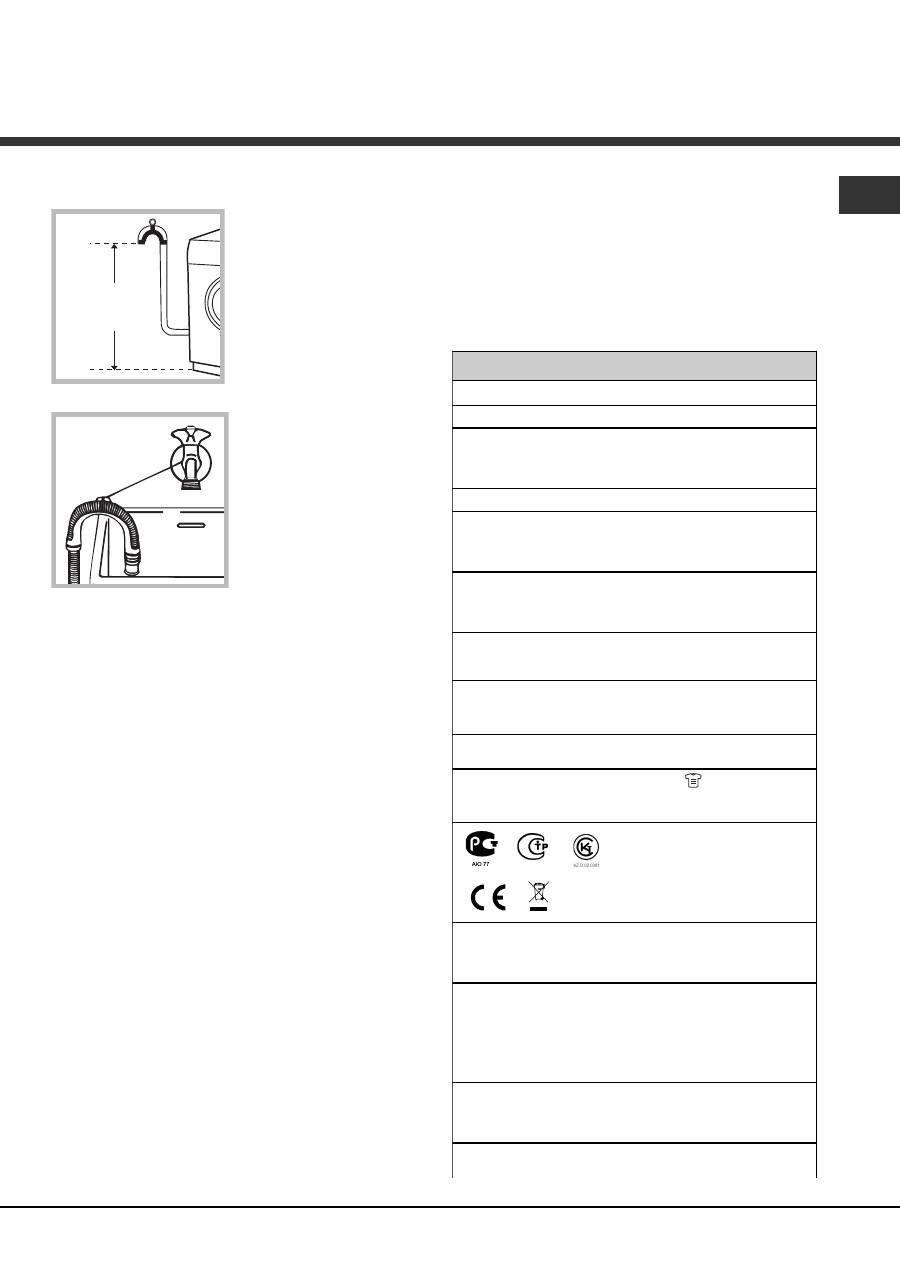
35
CIS
Ïîäñîåäèíåíèå ñëèâíîãî øëàíãà
Ïîäñîåäèíèòå ñëèâíîé
øëàíã, íå ñãèáàÿ åãî, ê
ñëèâíîìó òðóáîïðîâîäó
èëè ê ñëèâíîìó ïàòðóáêó
â ñòåíå,
ðàñïîëîæåííîìó íà
âûñîòå 65 100 ñì îò
ïîëà.
 êà÷åñòâå
àëüòåðíàòèâû ïîìåñòèòå
êîíåö ñëèâíîãî øëàíãà
â ðàêîâèíó èëè â âàííó,
ïðèêðåïèâ
ïðèëàãàþùóþñÿ
íàïðàâëÿþùóþ ê êðàíó
(ñì. ñõåìó).
Ñâîáîäíûé êîíåö
ñëèâíîãî øëàíãà íå
äîëæåí áûòü ïîãðóæåí â
âîäó.
! Íå ðåêîìåíäóåòñÿ èñïîëüçîâàòü óäëèíèòåëüíûå
øëàíãè. Ïðè íåîáõîäèìîñòè óäëèíåíèå äîëæíî
èìåòü òàêîé æå äèàìåòð, ÷òî è îðèãèíàëüíûé øëàíã,
è åãî äëèíà íå äîëæíà ïðåâûøàòü 150 ñì.
Ýëåêòðè÷åñêîå ïîäêëþ÷åíèå
Ïåðåä ïîäñîåäèíåíèåì øòåïñåëüíîé âèëêè èçäåëèÿ
ê ñåòåâîé ðîçåòêå íåîáõîäèìî ïðîâåðèòü
ñëåäóþùåå:
ñåòåâàÿ ðîçåòêà äîëæíà áûòü çàçåìëåíà è
ñîîòâåòñòâîâàòü íîðìàòèâàì;
ñåòåâàÿ ðîçåòêà äîëæíà áûòü ðàñ÷èòàíà íà
ìàêñèìàëüíóþ ìîùíîñòü ñòèðàëüíîé ìàøèíû,
óêàçàííóþ â òàáëèöå Òåõíè÷åñêèå äàííûå
(ñì.
òàáëèöó ñáîêó);
íàïðÿæåíèå ýëåêòðîïèòàíèÿ äîëæíî
ñîîòâåòñòâîâàòü çíà÷åíèÿì, óêàçàííûì â òàáëèöå
Òåõíè÷åñêèå äàííûå (
ñì. òàáëèöó ñáîêó);
ñåòåâàÿ ðîçåòêà äîëæíà áûòü ñîâìåñòèìà
øòåïñåëüíîé âèëêîé ìàøèíû. Â ïðîòèâíîì
ñëó÷àå íåîáõîäèìî çàìåíèòü ðîçåòêó èëè âèëêó.
! Çàïðåùàåòñÿ óñòàíàâëèâàòü ñòèðàëüíóþ ìàøèíó
íà óëèöå, äàæå ïîä íàâåñîì, òàê êàê ÿâëÿåòñÿ
÷ðåçâû÷àéíî îïàñíûì ïîäâåðãàòü åå âîçäåéñòâèþ
äîæäÿ è ãðîçû.
! Ñòèðàëüíàÿ ìàøèíà äîëæíà áûòü óñòàíîâëåíà òàê,
÷òîáû äîñòóï ê ñåòåâîé ðîçåòêå îñòàâàëñÿ
ñâîáîäíûì.
!
Íå èñïîëüçóéòå óäëèíèòåëè è òðîéíèêè.
!
Ñåòåâîé êàáåëü èçäåëèÿ íå äîëæåí áûòü ñîãíóò
èëè ñæàò.
!
Çàìåíà ñåòåâîãî êàáåëÿ ìîæåò îñóùåñòâëÿòüñÿ
òîëüêî óïîëíîìî÷åííûìè òåõíèêàìè.
Âíèìàíèå! Ïðîèçâîäèòåëü ñíèìàåò ñ ñåáÿ âñÿêóþ
îòâåòñòâåííîñòü â ñëó÷àå íåñîáëþäåíèÿ óêàçàííûõ
íîðì óñòàíîâêè è ïîäêëþ÷åíèÿ îáîðóäîâàíèÿ.
65 - 100 cm
Òåõíè÷åñêèå õàðàêòåðèñòèêè
Ìîäåëü
AQLF8F 292 U
Ñòðàíà-èçãîòîâèòåëü
Èòàëèÿ
Ãàáàðèòíûå
ðàçìåðû
øèðèíà 59,5 ñì
âûñîòà 85 ñì
ãëóáèíà 64,5 ñì
Âìåñòèìîñòü
1 - 8 êã
Íîìèíàëüíîå çíà÷åíèå
íàïðÿæåíèÿ
ýëåêòðîïèòàíèÿ èëè
äèàïàçîí íàïðÿæåíèÿ
220-240 V ~
Óñëîâíîå îáîçíà÷åíèå
ðîäà ýëåêòðè÷åñêîãî òîêà
èëè íîìèíàëüíàÿ ÷àñòîòà
ïåðåìåííîãî òîêà
50 Hz
Këàññ çàøèòû îò
ïîðàæåíèÿ
ýëåêòðè÷åñêèì òîêîì
Ê Këàññ çàùèòû I
Ãèäðàâëè÷åñêèå
ïàðàìåòðû
max äàâëåíèå 1 Ìïà (10 áàð)
min äàâëåíèå 0,05 Ìïà (0,5 áàð)
îáúåì áàðàáàíà 62 ë
Ñêîðîñòü îòæèìà
äî 1200 îá/ìèí
Kîíòðîëüíûå ïðîãðàììû
ñîãëàñíî íîðìàòèâó
EN 60456
ïðîãðàììà ;
òåìïåðàòóðà 60°Ñ; ïðè çàãðóçêå
äî 8 êã.
Äàííîå èçäåëèå ñîîòâåòñòâóåò
ñëåäóþùèì Äèðåêòèâàì
Åâðîïåéñêîãî Ñîîáùåñòâà:
- 2004/108/ÑÅ (Ýëåêòðîìàãíèòíàÿ
ñîâìåñòèìîñòü);
- 2006/95/CE (Íèçêîå àïðÿæåíèå)
- 2002/96/CE
 ñëó÷àå íåîáõîäèìîñòè ïîëó÷åíèÿ èíôîðìàöèè ïî ñåðòèôèêàòàì
ñîîòâåòñòâèÿ èëè ïîëó÷åíèÿ êîïèé ñåðòèôèêàòîâ ñîîòâåòñòâèÿ íà
äàííóþ òåõíèêó, Âû ìîæåòå îòïðàâèòü çàïðîñ ïî ýëåêòðîííîìó
àäðåñó cert.rus@indesit.com.
Äàòó ïðîèçâîäñòâà
äàííîé òåõíèêè ìîæíî
ïîëó÷èòü èç ñåðèéíîãî
íîìåðà, ðàñïîëîæåííîãî
ïîä øòðèõ-êîäîì (S/N
XXXXXXXXX), ñëåäóþùèì
îáðàçîì
- 1-àÿ öèôðà â S/N ñîîòâåòñòâóåò
ïîñëåäíåé öèôðå ãîäà,
- 2-àÿ è 3-ÿ öèôðû â S/N -
ïîðÿäêîâîìó íîìåðó ìåñÿöà ãîäà,
- 4-àÿ è 5-àÿ öèôðû â S/N - äåíü
Ñòåïåíü çàùèòû îò ïîïàäàíèÿ òâåðäûõ ÷àñòèö è âëàãè,
îáåñïå÷èâàåìàÿ çàùèòíîé îáîëî÷êîé, çà èñêëþ÷åíèåì
íèçêîâîëüòíîãî îáîðóäîâàíèÿ, íå èìåþùåãî çàùèòû îò âëàãè
:
IPX04
Këàññ
ýíåðãîïîòðåáëåíèÿ
A++
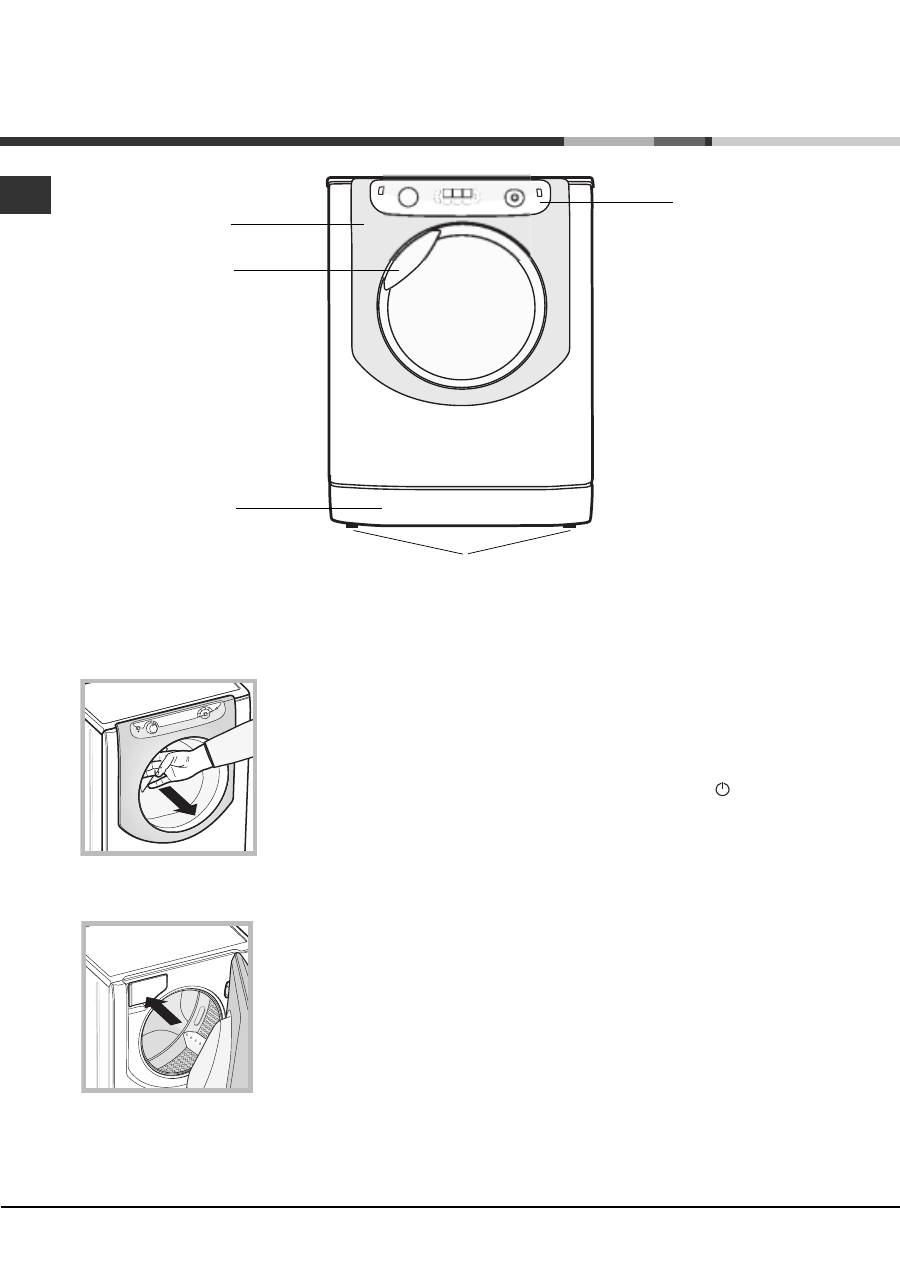
CIS
36
ÏÀÍÅËÜ
ÓÏÐÀÂËÅÍÈß
ËÞÊ
ÐÓ×ÊÀ ËÞÊÀ
ÏËÈÍÒÓÑ
ÐÅÃÓËÈÐÓÅÌÛÅ
ÍÎÆÊÈ
Îïèñàíèå ñòèðàëüíîé ìàøèíû
ËÞÊ
Äëÿ îòêðûâàíèÿ ëþêà
âñåãäà èñïîëüçóéòå
ñïåöèàëüíóþ ðó÷êó
(ñì.
ñõåìó).
ÄÎÇÀÒÎÐ ÑÒÈÐÀËÜÍÎÃÎ ÂÅÙÅÑÒÂÀ
Äîçàòîð íàõîäèòñÿ âíóòðè
ìàøèíû è äîñòóïåí ÷åðåç
ëþê. Ïîðÿäîê
èñïîëüçîâàíèÿ ñìîòðèòå â
ðàçäåëå
Auto Dose
System
.
Ïðèìå÷àíèå
: íàêëåéòå
íà äîçàòîð ñòèðàëüíîãî
âåùåñòâà íàêëåéêó ñ
ïåðå÷íåì ïðîãðàìì è
äîïîëíèòåëüíûõ
ôóíêöèé. Íàêëåéêà íàõîäèòñÿ â ïàêåòå âìåñòå ñ
íàñòîÿùèì òåõíè÷åñêèì ðóêîâîäñòâîì.
Ðåæèì îæèäàíèÿ
Íàñòîÿùàÿ ñòèðàëüíàÿ ìàøèíà îòâå÷àåò òðåáîâàíèÿì
íîâûõ íîðìàòèâîâ ïî ýêîíîìèè ýëåêòðîýíåðãèè,
óêîìïëåêòîâàíà ñèñòåìîé àâòîìàòè÷åñêîãî
îòêëþ÷åíèÿ (ðåæèì ñîõðàíåíèÿ ýíåðãèè),
âêëþ÷àþùåéñÿ ÷åðåç 30 ìèíóò ïðîñòîÿ ìàøèíû.
Íàæìèòå îäèí ðàç êíîïêó ON/OFF è ïîäîæäèòå,
ïîêà ìàøèíà âíîâü âêëþ÷èòñÿ.
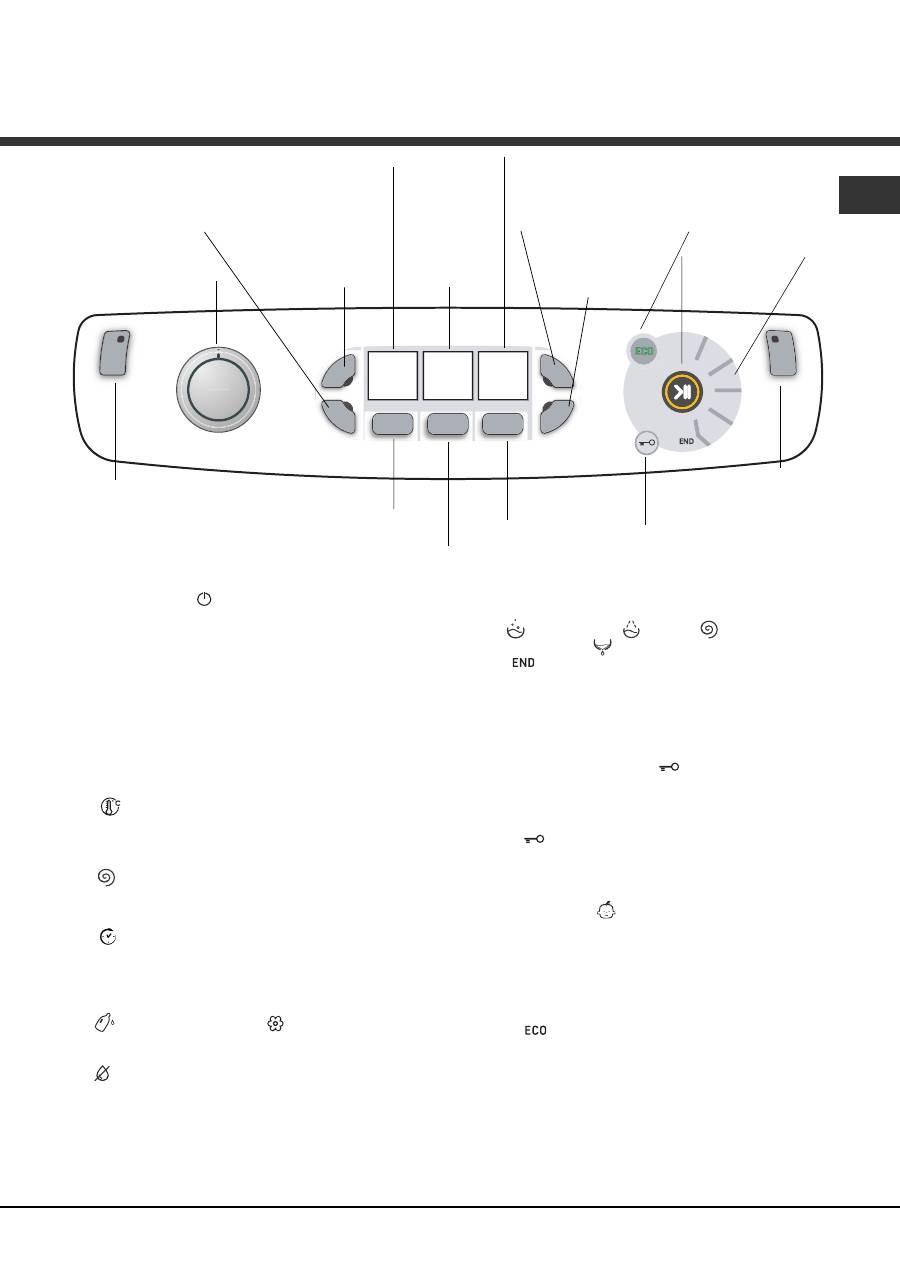
37
CIS
Ïàíåëü óïðàâëåíèÿ
Êíîïêà ñ èíäèêàòîðîì
ON/OFF:
íàæìèòå êíîïêó îäèí
ðàç äëÿ âêëþ÷åíèÿ èëè âûêëþ÷åíèÿ ìàøèíû. Çåëåíûé
èíäèêàòîð ïîêàçûâàåò, ÷òî ìàøèíà âêëþ÷åíà. Äëÿ
âûêëþ÷åíèÿ ñòèðàëüíîé ìàøèíû â ïðîöåññå ñòèðêè
íåîáõîäèìî äåðæàòü íàæàòîé êíîïêó, ïðèìåðíî 3
ñåêóíäû. Êîðîòêîå èëè ñëó÷àéíîå íàæàòèå íå ïðèâåäåò
ê îòêëþ÷åíèþ ìàøèíû.  ñëó÷àå âûêëþ÷åíèÿ ìàøèíû â
ïðîöåññå ñòèðêè òåêóùèé öèêë îòìåíÿåòñÿ.
Ðóêîÿòêà
ÏÐÎÃÐÀÌÌÛ:
ìîæåò âðàùàòüñÿ â îáå
ñòîðîíû. Äëÿ âûáîðà íóæíîé ïðîãðàììû ñìîòðèòå
«Òàáëèöà ïðîãðàìì».
 ïðîöåññå ñòèðêè ðóêîÿòêà íå âðàùàåòñÿ.
Êíîïêà
ÒÅÌÏÅÐÀÒÓÐÛ:
íàæìèòå äëÿ èçìåíåíèÿ
èëè èñêëþ÷åíèÿ íàãðåâà. Çàäàííîå çíà÷åíèå
ïîêàçûâàåòñÿ íà äèñïëåå ñâåðõó
(ñì. Ïîðÿäîê
âûïîëíåíèÿ öèêëà ñòèðêè).
Êíîïêà
ÎÒÆÈÌ:
íàæìèòå äëÿ èçìåíåíèÿ èëè
èñêëþ÷åíèÿ îòæèìà. Çàäàííîå çíà÷åíèå ïîêàçûâàåòñÿ íà
äèñïëåå ñâåðõó
(ñì. Ïîðÿäîê âûïîëíåíèÿ öèêëà ñòèðêè).
Êíîïêà
ÎÒËÎÆÅÍÍÛÉ ÇÀÏÓÑÊ:
íàæìèòå äëÿ
ïðîãðàììèðîâàíèÿ çàäåðæêè ïóñêà âûáðàííîé
ïðîãðàììû. Çàäàííîå çíà÷åíèå çàäåðæêè
ïîêàçûâàåòñÿ íà äèñïëåå ñâåðõó
(ñì. Ïîðÿäîê
âûïîëíåíèÿ öèêëà ñòèðêè).
Êíîïêè
ÌÎÞÙEE ÑÐEÄÑÒÂÎ
è
ÎÏÎËÀÑÊÈÂÀÒÅËÜ:
ñìîòðèòå
«Èçìåíåíèå ïàðàìåòðîâ, çàäàííûõ íà
ôàáðèêå»
â ðàçäåëå "
Auto Dose System
".
Êíîïêà
êîíöåíòðèðîâàííîå ìîþùåå ñðåäñòâî:
ñìîòðèòå «
Íàïîëíåíèå åìêîñòåé
» â ðàçäåëå
"Auto
Dose System".
Êíîïêà ñ èíäèêàòîðû
ÄÎÏÎËÍÈÒÅËÜÍÛÅ ÔÓÍÊÖÈÈ:
íàæìèòå äëÿ âûáîðà èìåþùèõñÿ äîïîëíèòåëüíûõ
ôóíêöèé. Èíäèêàòîð âûáðàííîé äîïîëíèòåëüíîé
ôóíêöèè çàãîðàåòñÿ
(ñì. Ïîðÿäîê âûïîëíåíèÿ öèêëà
ñòèðêè).
Ñèìâîëû
ÔÀÇÛ ÑÒÈÐÊÈ:
çàãîðàþòñÿ äëÿ
âèçóàëèçàöèè ïîñëåäîâàòåëüíîñòè âûïîëíåíèÿ öèêëà
(Ñòèðêà
Ïoëockaíèe - Îòæèì
-
Îêîí÷àòåëüíûé ñëèâ
).
Íàäïèñü
çàãîðàåòñÿ ïî çàâåðøåíèè öèêëà.
Êíîïêà ñ èíäèêàòîðîì
ÏÓÑÊ/ÏÀÓÇÀ:
êîãäà çåëåíûé
èíäèêàòîð ðåäêî ìèãàåò, íàæìèòå êíîïêó äëÿ ïóñêà
öèêëà ñòèðêè. Ïîñëå ïóñêà öèêëà èíäèêàòîð ïåðåñòàåò
ìèãàòü. Äëÿ ïðåðûâàíèÿ ñòèðêè âíîâü íàæìèòå êíîïêó,
èíäèêàòîð çàìèãàåò îðàíæåâûì öâåòîì. Åñëè
èíäèêàòîð «Áëîêèðîâêà ëþêà»
ïîãàñ, ìîæíî
îòêðûòü ëþê.
Äëÿ âîçîáíîâëåíèÿ ñòèðêè ñ ìîìåíòà, êîãäà îíà áûëà
ïðåðâàíà, âíîâü íàæìèòå ýòó êíîïêó.
Èíäèêàòîð
ÁËÎÊÈÐÎÂÊÀ ËÞÊÀ:
ïîêàçûâàåò, ÷òî
ëþê çàáëîêèðîâàí. Äëÿ îòêðûâàíèÿ ëþêà íåîáõîäèìî
ïðåðâàòü öèêë (ñì
«Ïîðÿäîê âûïîëíåíèÿ öèêëà
ñòèðêè»).
Êíîïêà ñ èíäèêàòîðîì
ÇÀÙÈÒÀ ÎÒ ËÅÒÅÉ:
äëÿ
âêëþ÷åíèÿ èëè îòêëþ÷åíèÿ áëîêèðîâêè êîíñîëè
óïðàâëåíèÿ äåðæèòå êíîïêó íàæàòîé ïðèìåðíî 2
ñåêóíäû. Âêëþ÷åííûé èíäèêàòîð îçíà÷àåò, ÷òî êîíñîëü
óïðàâëåíèÿ çàáëîêèðîâàíà. Òàêèì îáðàçîì
ïðîãðàììà íå ìîæåò áûòü ñëó÷àéíî èçìåíåíà,
îñîáåííî åñëè â äîìå äåòè.
Èíäèêàòîð
çàãîðàåòñÿ, êîãäà ïðè èçìåíåíèè
ïàðàìåòðîâ ñòèðêè ïîëó÷àåòñÿ ýêîíîìèÿ
ýëåêòðîýíåðãèè íå ìåíåå ÷åì íà 10%. Êðîìå òîãî ïåðåä
òåì êàê ìàøèíà ïåðåêëþ÷èòñÿ â ðåæèì ñîõðàíåíèÿ
ýíåðãèè, ñèìâîë çàãîðèòñÿ íà íåñêîëüêî ñåêóíä. Ïðè
âûêëþ÷åííîé ìàøèíå ïðèìåðíàÿ ýêîíîìèÿ
ýëåêòðîýíåðãèè ñîñòàâëÿåò ïðèìåðíî 80%.
Êíîïêà
ÒÅÌÏÅÐÀÒÓÐÛ
Ðó÷êà âûáîðà
ïðîãðàìì
Êíîïêè
êîíöåíòðèðîâàííîå
ìîþùåå ñðåäñòâî
Èíäèêàòîð
ÁËÎÊÈÐÎÂÊÀ ËÞÊÀ
Êíîïêà ñ
èíäèêàòîðîì
ÏÓÑÊ/ÏÀÓÇÀ
Ñèìâîëû
ÔÀÇÛ
ÑÒÈÐÊÈ
Êíîïêà
ÎÒÆÈÌ
Êíîïêà ñ
èíäèêàòîðîì
ÇÀÙÈÒÀ ÎÒ
ËÅÒÅÉ
Êíîïêà ñ
èíäèêàòîðîì
ON/OFF
Èíäèêàòîð
ECO
Êíîïêà
è
èíäèêàòîðû
ÄÎÏÎËÍÈÒÅËÜÍÛÅ
ÔÓÍÊÖÈÈ
Äèñïëåé
ÒÅÌÏÅÐÀÒÓÐÛ/
ÑÒÈÐÀËÜÍÎÅ ÂÅÙÅÑÒÂÎ
Äèñïëåé
ÎÒÆÈÌÀ
Äèñïëåé
ÎÒËÎÆÅÍÍÛÉ ÇÀÏÓÑÊ/
ÎÏÎËÀÑÊÈÂÀÒÅËÜ/ÏÐÎÄÎËÆÈÒÅËÜÍÎÑÒÈ
ÖÈÊËÀ
Êíîïêà
ÎÒËÎÆÅÍÍÛÉ
ÇÀÏÓÑÊ
Êíîïêà
ÑÒÈÐÀËÜÍÎÅ
ÂÅÙÅÑÒÂÎ
Êíîïêà
ÎÏÎËÀÑÊÈÂÀÒÅËÜ

